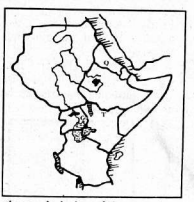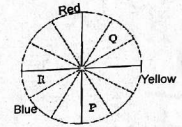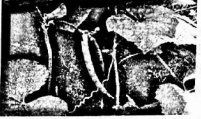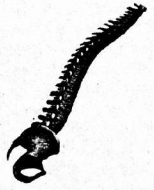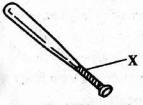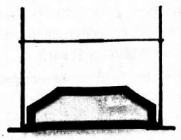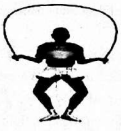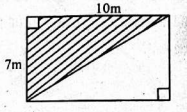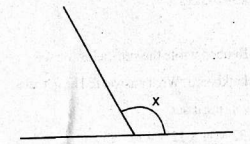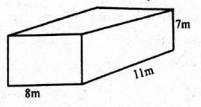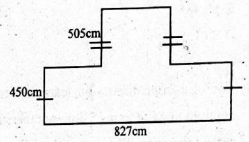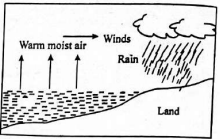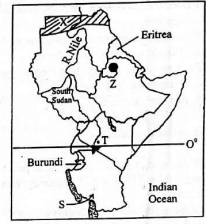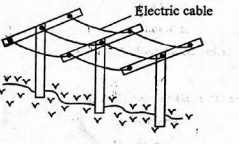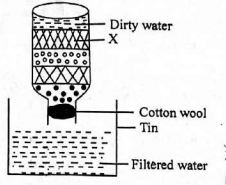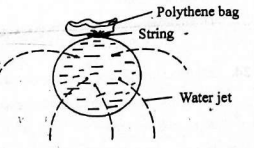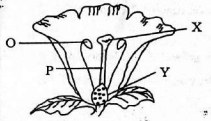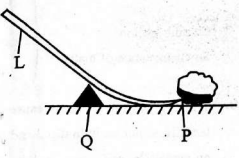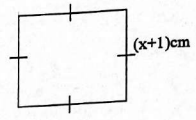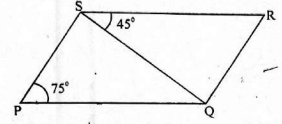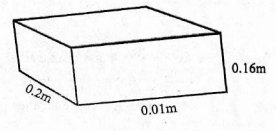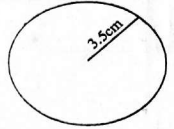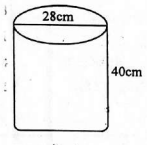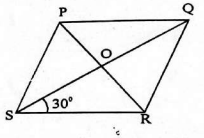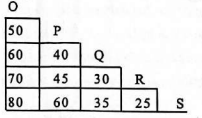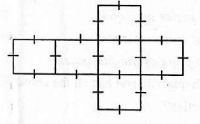Stella
Creative Arts & Social Studies Questions and Answers - Grade 6 End Term 1 Exams 2023 Set 2
CREATIVE ARTS AND SOCIAL STUDIES
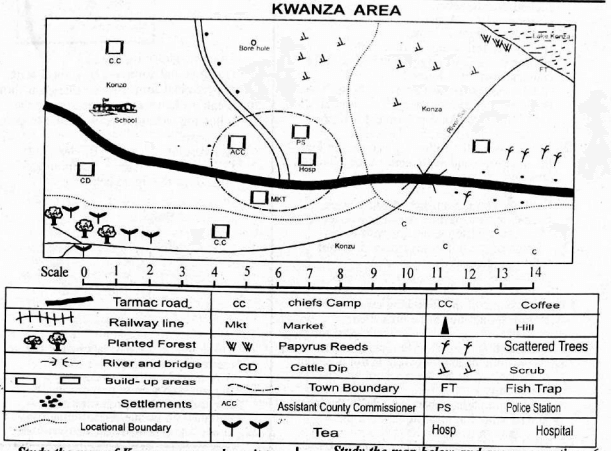
Study the map of Kwanza area and use it to answer questions 1 - 5.
- Which one of the following pairs of crops are grow in Kwanza area?
- Rice and tea
- Tea and coffee
- Sisal and cotton
- Coffee and Sugarcane.
- The population of Kwanza area can be described as
- dense
- scattered
- sparse
- nuclear.
- What is the direction of the borehole from the market in Kwanza area?
- North
- South
- North East
- South West
- What is the general flow of river Soi in Kwanza area?
- East
- South West
- North East
- South.
- The climate in Konzu location can be described as
- cool and wet
- cool and dry
- hot and wet
- hot and dry.
Study the map below and answer questions 6 to 8.
- What is the capital city of the country labelled Q?
- Asmara
- Khartoum
- Kampala
- Zanzibar.
- The vegetation found in the area marked T is
- Sub-tropical
- Mountain
- Desert
- Equatorial.
- The mountain marked G is
- Mt. Kenya
- Mt. Elgon
- Mt. Ruwenzori
- Mt. Gimbala.
- Which of the following is not an example of a historic built environment?
- Jomo Kenyatta statue in Nairobi.
- Bombolulu cultural centre in Mombasa.
- Kisumu museum in Kisumu.
- Moi International Airport in Mombasa.
- Which one of the groups is made up of Bantus only?
- Basoga, Hehe, Pare.
- Alur, Nandi, Sebei.
- Borana, Tutsi, Adere.
- Amhara, Tigre, Falasha.
- Which one following historic built environments is wrongly matched with the country where it is found?
- John Garang Mausoleum - South Sudan
- Independence monument - Burundi
- St. Francis of Asisi monument - Kenya
- The people's Palace - Djibouti
- Which one of the following is a reason for the migration and settlement of the Nilotes language groups in Eastern Africa?
- To spread Islam.
- Moving away from drought and hunger.
- Looking for pasture for their livestock.
- Looking for fertile land to grow crops.
- Which of the following factors does not influence population distribution?
- Relief
- Pests and diseases
- Insecurity
- Sunshine.
- Which one of the following aspects of our culture should not to be preserved?
- Raids.
- Traditional foods.
- Wrestling.
- Traditional attires.
- Which one of the following is not a benefit of collaboration between school and the community?
- Community members get jobs in the school.
- The school admits pupils from the community.
- The pupils work in the community farms.
- The school get learning materials from the community.
- Purity listed materials she would use to make a mat. Which of the following is a man-made material?
- Raffia
- Acrylic yarn
- Reeds
- Sisal fibre.
- Grace mounted the artwork below ready for an exhibition.
The technique used to mount the artwork above is- window mounting
- trimming technique
- pasting technique
- sticking technique.
- Jonathan mixed equal amounts of red and blue colours. Wha colour did he get?
- Green
- Yellow
- Orange
- Purple.
- Rebecca Saw the pottery item below at an artworkshop.
The form above is called a- cylindrical form
- conical form
- pyramidal form
- triangular form.
- Sarah made her pots. Which one of the following techniques can she use to decorate her items?
- Kneading
- Thonging
- Incising
- Splitting.
- Alex drew the figure below.
The colour in the part labelled R can be created by mixing- blue with red proportionality
- green and yellow proportionality
- red and orange proportionality
- blue with purple proportionality.
- Grade 5 pupils made the item below.
Which one of the following techniques were they not likely to use to decorate the item?- Smoking
- Embedding
- Incising
- Texturing
- Linet was making improvised crayons using bee wax. Which of the following reasons explains why she used two containers when melting the wax? To
- melt slowly
- ensure consistency in melting
- prevent fire accidents since wax is flammable
- enable the colour to mix well.
- Priscah was planning an art exhibition. Which of the following factors was she not likely to consider in the preparation?
- Proper use of space.
- Colour contrast of the background.
- Background music.
- Placement of artwork.
- During a photography lesson, Grade 6 learners were learning about principles of photography. Which one of the following were they not likely to discuss?
- View point
- Value
- Lighting
- Centre of interest.
- Grade six learners were asked to write down different parts of a fiddle and their functions. Which one of the following parts is correctly matched with its function?
- String: Vibrates to produce sound.
- Bridge: Used for tightening the string.
- Tuning peg: Amplifies the sound.
- Bow: Transfers sound to the resonator.
- Grade 4 learners wrote down the importance of folk songs as below. Which one of the following statements is false?
- Makes us appreciate other people's cultures.
- It is a source of livelihood.
- Promotes unity among various people.
- It leads to unfair competition between communities.
- Grade six learners visited the Bomas of Kenya to watch the performance of folk songs from various communities. During the performance of the Maasai traditional dance, the dancers got into intense dancing session marked with louder playing of instruments and more vigorous dancing. This feature of a folk song is known as
- mood
- climax
- musical speed
- structure.
- Some learners listed down the importance of caring for the musical instruments. Which one of the following statements is false regarding taking care of instruments?
- Saves time used in making new investments.
- Saves money used to buy new instruments.
- Saves resources used to make new instruments.
- Makes instruments to fade well.
- Grade 5 learners were asked to name musical instruments from different communities in Kenya. Four of the learners gave the following answers. Who among them gave an example of melodic percussion instrument?
- Akelo: Guitar
- Wacike: Wandindi
- Naliaka: Drum
- Wambui: Adongo
Grade six learners visited a music store. They saw the musical instrument shown below. Use it to answer questions 21-22.
- The instrument shown above is known as
- Fiddle
- Traditional guitar
- Abu
- Coro
- The part labelled X is called
- bridge
- drum
- resonator
- amplifier.
- Kariuki was asked to write down values mentioned in the East African community Anthem. He wrote three of the following values except
- patriotism
- nepotism
- unity
- peace.
- Which of the following is not a type of a song?
- Patriotic
- Lullaby.
- Famous
- Popular
- Abigael was asked to clap the rhythm below and then write the corresponding French rhythm. Which of the rhythm matches the clapping?
- taa-aa-aa
- taa-tate-taa
- tate taa-tate
- taa-ta-te-ta-te
PART 2: Choose a section you have prepared for. Each section is 10 marks
CHRISTIAN RELIGIOUS EDUCATION
- Ann has a talent in sewing. During her leisure time, she was seen trying to make new designs from the internet. Which value does she have that can improve her talent?
- Respect
- Integrity
- Responsibility
- Honesty.
- Ouma's marriage was conducted at the county Commissioner's office. They were then given a certificate to sign. This type of marriage is. called
- religious
- civil
- customary
- traditional.
- According to Genesis 2:20- 24, God created a woman inorder to
- form a family with a man
- cook for the man
- be a man's helper
- bear children for the man.
- You have been asked to address a community that still practices early marriages. Which of the following will you not mention as a reason why early marriages should be discouraged? They
- violate children's rights
- may lead to successful life
- may cause death
- lower one's self-esteem.
- A teacher asked grade 5 learners to name different forms of leisure. They stated what they do as follows:
Tom - Reading storybooks
Mercy - Swimming in the pool.
Ted-Riding his bike.
Jack - Watching a movie.
Who among the following pupils did not mention passive leisure activities?- Tom and Mercy.
- Ted and Jack.
- Tom and Jack.
- Mercy and Ted.
- Which of the following best gives an opinion of rest according to the Bible? We should rest
- after completing our work
- when we feel tired
- when we are doing nothing
- because it makes God happy.
- The Bible is an inspired word of God. Jane researched the meaning of the word 'inspire'. Which one of the following is the best meaning of inspire? To
- make someone feel that she wants to do something
- discourage someone from doing something
- make someone lose confidence in self
- give someone an idea of doing something.
- Who among the following authors is wrongly matched with the books they wrote?
- David Psalms
- Paul - Colossians
- Solomon - Proverbs
- Moses - Kings
- The commandment that teaches the value of contentment is the _________________ commandment.
- 2nd
- 5th
- 4th
- 10th
- Samson loves his nation so much that he agreed to be handed over to the enemies to save his country. Which quality best describes his behaviour?
- Faith
- Courage
- Patriotism
- Honesty.
- The prophets who complained to Elisha were experiencing which problem?
- Lack of food.
- Their land was small.
- They had no water.
- They had disagreements.
- "I won't let you go unless you bless me." Who among the following said these words?
- David
- Saul
- Angel
- Jacob.
- Today, God calls people to serve Him through different ways. Which of the following is not amongst them? Through
- sacrifices
- visions
- dreams
- preaching.
- John and Jeff were asked the lessons they learn from the call of the first four disciples. Which of the following is not correct?
- We should be obedient to God's call.
- We should trust in Jesus.
- We should change our lifestyle when called by God.
- God chooses people to call for His service.
- "I will give you all these if you bow down and worship me.'
This was Jesus' __________________________ temptation.- 2nd
- 1st
- 3rd
- 4th
ISLAMIC RELIGIOUS EDUCATION
- Surahs condems many things. Which one of the following surahs condemns backbiting?
- Kawthar
- Humaza
- Zilzala
- Aadiyat.
- Grade 6 learners were discussing different ways of using their time well. Which surah were they mostly likely to refer to?
- Asr
- Fatiha
- Lahab
- Naas
- Complete the surah below.
"Latarawunnal al..........- Naiim
- Yaqiin
- Jahiim
- Maqaabir.
- Which one of the following is not a teaching of suratul Qaariah?
- Allah is the best of the judges.
- We should do good and avoid evil.
- The surah talks about the day of judgment.
- The surah teaches us about tawheed.
- Grade 6 learners were discussing about a hadith on purity of action. They concluded that Allah looks at our
- faces and wealth
- hearts and wealth
- deeds and hearts
- deeds and faces.
- Amina was given an assignment on qualities of a female's dress. Which of the following responses was wrong? The dress should
- cover what is between the navel and knees
- long and loose
- not be transparent
- cover the entire body.
- Which one of following is the third pillar of Iman? Belief in
- Allah
- His prophets
- the last day
- His books.
- Who is a muttaqin?
- A person who prays five times a day.
- A person who relies on Allah.
- God fearing person.
- Imam of a mosque.
- Grade 6 learners were discussing about occasions on which tawba is not accepted. Who among the following gave the correct answer?
- Yusuf- When the sun rises from the west.
- Khalid -When the sun rises from the east.
- Sofia - On Friday.
- Mariam - When one is sick.
- Sacrifice made during Eidul Adh-ha always reminds us of nabii
- Yusuf
- Yunus
- Ibrahim
- Musa.
- Zakah is a pillar of Islam. Who among the following is not a recipient of Zakah?
- Widows.
- Travelers.
- Poor.
- Zakat collectors.
- Which one of the following is a form continuous charity?
- Feeding a hungry person.
- Leading a prayer in the mosque.
- Planting a tree.
- Removing harmful things on the road.
- How can a Muslim girl apply the teachings of hadith on dressing in her life?
- Wearing mini-skirt.
- Copying dress of non-Muslims.
- Wearing tight clothing.
- Wearing loose and long dressing.
- On the day of Qiyama, we will be asked four questions concerning the following except
- wealth
- youth
- age
- children.
- Which Prophet of Allah was tempted by a woman but Allah protected him?
- Musa
- Yusuf
- Issa
- Nuh.
MARKING SCHEME
SOCIAL STUDIES
- B
- C
- A
- C
- A
- A
- C
- B
- D
- A
- C
- C
- D
- A
- C
- B
- A
- D
- C
- C
- D
- D
- C
- C
- B
- A
- D
- B
- D
- D
- A
- C
- B
- C
- D
CRE
- B
- B
- C
- B
- D
- A
- A
- D
- D
- C
- B
- D
- A
- D
- A
IRE
- B
- A
- C
- D
- C
- A
- D
- C
- A
- C
- A
- C
- D
- D
- B
Integrated Science Questions and Answers - Grade 6 End Term 1 Exams 2023 Set 2
QUESTIONS
- John saw the picture shown below on his way home. What type of soil erosion did he see?
- Sheet erosion
- Splash erosion
- Gulley erosion
- Rill erosion.
- Depressions in which plants are grown and are very useful where there is little rain are called
- sunken beds
- gulley beds
- tunnel beds
- potholes.
- The following are deterrents that keep animals from destroying our crops. Which one is not?
- Wire mesh
- Safe traps
- Deflectors
- Thorny fences.
- Plants with weak stems that grow along the ground are called
- vegetable plants
- creeping plants
- mangrove plants
- fruits.
- John grew the vegetable crop below in his farm.
What is the name of the vegetable crop shown above?- Spinach
- Cabbage
- Carrot
- Lentil.
- The following are tools and equipment used when caring for vegetable crops. Which one is not?
- Wheelbarrow
- Watering can
- Rake
- Jembe.
- When we start cultivating crops, we first sow the seeds in a nursery and take care of them until they are ready for transplanting. Which of the following is a step involved when taking care of nurseries?
- Mulching
- Pruning
- Harvesting
- Intercropping.
- The following are benefits of growing vegetables in the garden. Which one is not?
- It saves money on food.
- It is enjoyable doing planting activities.
- Planting vegetables minimizes waste.
- It makes us rich.
- Which one of the following is an indigenous food crop?
- Maize
- Sorghum
- Kales
- Cabbage.
- Domestic animals are kept at home for the following reasons except
- to provide security
- providing foodstuff such as milk and eggs
- to provide labour
- to babysit.
- Wild animals can be a problem as they destroy our crops and domestic animals. Which of the following is a way of dealing with them without harming them?
- Use of sound devices such as metallic plates.
- Use of poison.
- Use of traps.
- Shooting them with arrows.
- Which one of the following is a disease that we can get from being bitten or scratched by wild animals?
- Diarrhoea
- Epilepsy
- Rabies
- Malaria.
- The practice of planting crops to cover soil so that little water evaporates is called
- intercropping
- covercropping
- mulching
- shading.
- The practice of alteration of the properties of soil to improve its performance is called
- soil erosion
- soil improvement
- soil alteration
- soil organization.
- An advantage of using organic manure is that they
- can be used for a long time without affecting the soil
- cause soil erosion.
- make the soil change colour
- make the plants sweeter.
- Vertebrates are animals that
- have backbones
- do not have backbones.
- have hair or fur on their bodies
- live in the water.
- The following are flowering plants except
- bean
- algae
- orange
- passion.
- Which one of the following is not a sense organ in a human being?
- Eyes
- Tongue
- Head
- Skin
- The figure below shows a certain body muscle.
Which one of the following is not a function of the above muscles?- Protects the internal body organs.
- Helps us stand upright.
- Supports the upper body.
- Helps us to turn and twist our back.
- When we breathe in, the body takes in and uses oxygen. Which gas do we breathe out and pass as a waste product?
- Water vapour.
- Nitrogen
- Carbon monoxide
- Carbon dioxide.
- After a heavy rain season, children in Sakari area developed some cold and coughs. Which of the following is a sign and symptom of colds?
- Nose block and sore throats.
- Body aches and headache.
- Fever and sweating.
- Pain in the chest when coughing.
- The following are main measures which should be taken in the prevention of cholera. Which one is not?
- Covering cooked food to prevent flies from contaminating them.
- Washing hands with soap and water after visiting the toilet and before handling food.
- Drinking clean boiled or treated water.
- Wearing protective clothes like gumboots and water tight gloves while working in stagnant water.
- A bedbug is an external parasite. What is the meaning of an external parasite?
- Small living things that are found on the skin of human beings.
- Small living things that are found inside the body of human beings.
- Creatures found underneath the water.
- Living things that feed on dead animals.
- Grade 5 learners observed the picture below from internet.
What is the name of the parasite shown?- Round worms.
- Lice
- Hookworms.
- Tapeworm.
- The following are the things you will need to key in information in a computer. Which one is used in typing?
- The mouse
- Monitor
- A CPU
- Keyboard.
- Miriam wanted to go shopping and her mother gave her a shopping list. What is the importance of the shopping list?
- It helps save money as a person only buys what they need.
- It enables one to buy anything they like.
- It enables one to spend a lot of money.
- It makes one waste a lot of time.
- The following are factors we should consider when choosing foods from the general grocery. Which one is not?
- The type of material the packaging is made of.
- The weight of the food item.
- If the food item is popular.
- The price of the food items.
- John was advised by the doctor to take a balanced diet. What does a balanced diet consist of?
- Carbohydrates and vitamins only.
- Carbohydrates and minerals only.
- Proteins, carbohydrates and vitamins.
- Proteins and minerals only.
- The cooking method where food is placed inside a pan filled with hot oil is called
- steaming
- boiling
- grilling
- deep frying.
- The following are hygiene practices to be observed except
- brushing teeth everyday
- combing the hair regularly
- taking a bath daily and wearing clean clothes
- using a lot of deodorant when you haven'tbathed.
- The youths are advised to positively make use of digital devices. In what ways can they use digital devices positively?
- Searching for information from the internet.
- Playing video games.
- Watching scary movies.
- Using the internet to bully others.
- Malia wants to make mandazis by deep frying them. What precautions does she need to observe to avoid injury?
- Not filling the pan with oil until it is full.
- Placing the mandazis only when the oil is coiling hot.
- Throwing the mandazi in the oil and stay far away from the pan.
- Pouring water on the oil if it gets too hot.
- Most kitchen tools are made of the following materials except
- melamine
- plastics
- aluminium
- ballast.
- As Ben was cleaning dishes, he realized that he didn't have a scrubber. What material can he use instead?
- Charcoal
- Soil
- Brush
- Sponge.
- Sasha likes using accessories. Which of the following is among her accessories?
- Lips tick
- Bracelet
- Perfume
- Shampoo.
- The following are symptoms of a heart attack. Which one is not?
- Feeling exhausted.
- Chest pain.
- Irregular and rapid heartbeats.
- Diahorrea.
- Grade five learners were asked to discuss the importance of good time management. They came up with the following points. Which one is not correct? It helps us to
- finish our work on time
- do more tasks in less time
- achieve what we want faster
- become strong.
- Grade 4 learners were asked to match cleaning tools with materials used for making them. Which one of the following was not correctly matched?
- Broom: Wires, twigs, reeds.
- Dusters: Feathers or soft pieces of cloth.
- Mops: Coconut fibres or sisal fibres.
- Dust pan: Old jerry can or carton boxes.
- Communicable diseases can be passed from one person to another. Which one of the following is a communicable disease?
- Diabetes
- Coughs and colds
- Epilepsy
- High blood pressure.
- When performing a two-handed catch technique in ball games, where should the eye be facing?
- Down on the ball.
- Back of the ball.
- On the coming ball.
- Over the ball.
- A pupil performed a throw while his hips and shoulders were rotating and the throwing arm was moving downward and upward. Which pass was he performing?
- Chest pass
- Over arm pass
- Under arm pass
- Shoulder pass
- Grade 4 learners listed down places where they could play their games during free times. Which of the following places is secure?
- In the playground.
- In the dining hall.
- In the swimming pool.
- Along a busy highway.
- The following are types of passes used in soccer. Which one is not?
- Instep
- Ball of foot
- Inside of foot
- Overarm pass.
- The figure below shows a rounder's bat.
The part marked X is mostly covered by- wax
- rubber
- metal
- wool.
- Mr. Jumwa gave his grade 4 learners different ropes. Which of the following activities can they play using the rope?
- Dancing
- Hide and seek
- Skipping
- Bean bay game.
- The Warrior team have a match in the afternoon. They have to practice in the morning. Which one of the following is a cool down activity that they can perform?
- Slow dance
- Rabbit jumps
- Squat jumps
- Frog jumps.
- Abel saw the facility below in the field. What is the name of the facility shown?
- Serving area
- Landing area
- Clearing area
- Pivot point.
- The best weight for a javelin to be used by grade 6 learners should be
- 200g
- 400g
- 1kg
- 250g.
- The following are steps used in releasing a javelin.
- Throw in a straight line at the top.
- Withdraw the javelin.
- Release the javelin from the fingers.
- Stand facing forward with body turned
Which of the following is the correct order of performing the release?- (iv), (i), (ii), (iii)
- (ii), (i), (iv), (iii)
- (iii), (iv), (i), (ii)
- (iv), (ii), (iii), (i)
- A Grade 6 learner was seen performing the activity below. Which technique was he performing?
- Straddle
- Wounded duck
- Straddle cross
- Skier.
MARKING SCHEME
- D
- A
- C
- B
- D
- A
- A
- D
- B
- D
- A
- C
- B
- B
- A
- A
- B
- C
- A
- D
- A
- D
- A
- D
- D
- A
- C
- C
- D
- D
- A
- A
- D
- B
- B
- D
- B
- A
- B
- C
- B
- A
- D
- B
- C
- A
- B
- B
- D
- C
Kiswahili-Lugha Questions and Answers - Grade 6 End Term 1 Exams 2023 Set 2
Soma taarifa ifuatayo kisha ujibu maswali 1-5.
Kila mwaka shuleni kwetu huwa na sherehe za kutoa tuzo kwa walimu, wanafunzi, wafanyakazi na mtu yeyote yule aliyefanya jambo lolote jema au kitendo chochote cha manufaa shuleni. Walimu hutuzwa tuzo kutokana na juhudi zao za kufunza vizuri. Wapishi hutuzwa kwa kuandaa mlo mtamu, usafi na kupika kwa wakati bila kuchelewa. Madereva nao hutuzwa kwa kuendesha magari ya shule kwa utaratibu, kuwa na nidhamu kwa wanafunzi wala kutosababisha ajali yoyote.
Wafagiaji na wahudumu wengine kama vile mabawabu, waktubi, mahazili na mtarishi pia hutuzwa. Muhula uliopita, sisi wanafunzi tulituzwa kwa maadili, usafi, bidii na matokeo bora katika kila somo. Waliofanya vizuri katika somo la michezo na uhusiano mwema baina ya wanafunzi pia walituzwa. Mimi nilituzwa kwa kuwa bora katika Kiswahili, kuwa na nidhamu kuliko wote, kuwa safi mwaka mzima na pia nikapata tuzo ya kutumia muda wangu vizuri. Nawe pia unaweza ukapata zawadi hata zaidi yangu. Usife moyo kwa sababu ipo siku!
Maswali
- Kila mwaka shuleni kuna sherehe zipi? Za
- kutwezwa
- kutwazwa
- kutuzwa
- kutozwa.
- Wafagiaji wa shuleni ni
- wapishi
- wahazili
- waktubi
- matopasi.
- Msimulizi alipata tuzo ngapi?
- Nne
- Nyingi
- Moja
- Tano.
- Wapishi hupewa zawadi kwa kuzingatia yafuatayo isipokuwa
- kupika vyakula vitamu
- kupika kwa wakati
- kupika vyakula nadhifu
- kupika haraka.
- Ni kweli kusema kuwa
- wanafunzi walipewa zawadi za kufuzu masomoni tu
- wanafunzi walituzwa kwa kufanya vyema katika nyanja zote shuleni
- walimu walipata tuzo kwa kufunza na kuvalia vizuri
- madereva walizawadiwa kwa kuendesha magari kwa kasi.
Soma kifungu kifuatacho kisha ujibu maswali 6-10.
Katika familia au ukoo kuna utaratibu wa maisha. Kuna watu wa rika tofauti. Kuna jinsia tofauti pia. Watu wa familia huishi kwa adabu, heshima na nidhamu zinazofuata umri na jinsia. Kwa hivyo, kuna jinsi ya kusalimiana kwa kuzingatia umri na jinsia. Binadamu ni jamii yenye nidhamu na isiyotenda mambo ovyoovyo kama wanyama wafanyavyo.
Hata utaratibu wa kula hufuata kanuni na sera maalum. Huo ndio ubinadamu na ubinadamu ndio utu wa watu. Tusifanye mambo shaghalabaghala kama hayawani. Familia isiyo na utaratibu wa nidhamu si familia tena! Familia nyingine hazina salamu wala habari. Hawajiheshimu, hawaheshimu wenzao wala kuheshimiana. Hakuna babu, nyanya, mtoto, baba, mavyaa, halati wala dada. Tukiishi hivyo, yule ng'ombe mwenye mkia na pembe ataishi vipi?
- Ukoo ni kikundi cha watu wanaotokana na
- kabila moja
- dini moja
- nasaba moja
- kijiji kimoja.
- Binadamu wenye utu na ubinadamu hufanya mambo yao kwa njia gani?
- Taratibu
- Ovyoovyo
- Shaghalabaghala
- Kiholela.
- Familia au ukoo ni sawa na
- kabila
- kijiji
- jamii
- jumla.
- Ni maamkuzi yapi hutumiwa kulingana na umri?
- Habari
- Sabalheri
- Hujambo
- Cheichei.
- Halati ni
- dada ya mama
- dada ya baba
- kaka ya mama
- kaka ya baba.
Soma shairi hili kisha ujibu maswali 11-15.
Mkono wa mkulima, ni mgumu kama chuma,
Chakula cha mkulima, ni maharage na sima,
Mtazame mkulima, hatulii juma zima,
Bali huyu mkulima, ndiye mama wa uzima.
Maisha ya mkulima, ni ya shida tangu zama,
Kibanda cha mkulima, huvuja na kutetema,
Mgongo wa mkulima, daima umeinama,
Bali huyu mkulima, ndiye mama wa uzima.
Nafasi ya mkulima, mara nyingi ni ya nyuma,
Magarini mkulima, kazi yake kusimama,
Hadharani mkulima, huambiwa hana jema,
Bali huyu mkulima, ndiye mama wa uzima.
Maswali
- 'Ni mgumu kama chuma' ni fani gani ya Lugha?
- Kitendawili
- Istiara
- Methali
- Tashbihi.
- Kwa nini mgongo wa mkulima daima umeinama? Kwa sababu
- ya kazi yake
- ni mzee
- ana shida
- nyumba yake ni ndogo.
- Hili ni shairi la aina gani?
- Tathlitha
- Tarbia
- Ngonjera
- Ukulima.
- Kibwagizo cha shairi hili kina maana gani?
- Mkulima ndiye atupaye uhai.
- Kwa chakula cha mkulima tunaishi.
- Mkulima ni mama yetu.
- Mtoto wa mkulima anaitwa Uzima.
- Kuna uwezekano mkubwa wa mkulima kupanda mbegu msimu upi?
- Kiangazi
- Kipupwe
- Mchoo
- Mafuriko.
Jaza mapengo kwa majibu mwafaka.
Kila mnyama ____16____meno ____17____ ya juu na ya chini. Binadamu mtu mzima huwa na meno thelathini na ___18___ .Wanyama wote wana meno ____19____ambayo ____20____sumu kali.
| A | B | C | D | |
| 16. | ako na | yuko na | ana | anazo |
| 17. | makali | kali | mikali | kubwa |
| 18. | miwili | mbili | mawili | viwili |
| 19. | mengi | nyingi | mingi | mwingi |
| 20. | zina | yana | una | ina |
Jibu maswali kulingana na maagizo.
- Maskani ________________________ hufagiliwa.
- zetu
- mwetu
- petu
- yetu
- Baba akikasirika huwa mkali kama ______________________
- moto
- pilipili
- simba
- jua
- Andika ukubwa wa sentensi ifuatayo.
Ndoo zetu zimepasuka.- Mandoo zetu zimepasuka.
- Madoo yetu yamepasuka.
- Ndoo zetu zimepasuka.
- Mandoo yetu yamepasuka.
- Tumia kiashiria sahihi.
Ugonjwa _____________________ ni hatari.- hiyo
- ile
- huo
- iyo
- Nilipokuwa katika ziara, niliona _____________________ ya milima.
- safu
- mabunda
- msafara
- milolongo
- Baba yangu amenunua gari _____________________
- mpya
- kipya
- zipya
- jipya.
- Chagua kiwakilishi cha idadi katika sentensi ifuatayo.
Watu wengi wana gari moja lakini wachache wana pikipiki mbili.- wengi
- moja
- wachache
- mbili.
- Kati ya viwakilishi vifuatavyo, ni kipi cha nafsi ya tatu katika wingi?
- Zao
- Yeye
- Nyinyi
- Wao.
- Tambua kivumishi katika sentensi hii.
Mama huyo alitembea haraka akafika vizuri.- mama
- huyo
- haraka
- vizuri
- Kipi si kiungo cha kusafisha damu?
- Pafu
- Buki
- Figo
- Nso.
INSHA
Umepewa dakika 40 kuandika insha yako.
Andika insha ya kusisimua kuhusu mada ifuatayo;
UCHAGUZI SHULENI MWETU.
MARKING SCHEME
- C
- D
- A
- D
- B
- C
- A
- C
- D
- A
- D
- A
- B
- B
- C
- C
- A
- C
- A
- B
- D
- C
- B
- C
- A
- D
- C
- D
- B
- A
English Questions and Answers - Grade 6 End Term 1 Exams 2023 Set 2
Read the story below and answer the questions that follow.
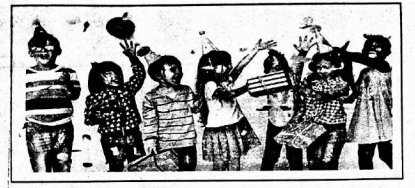
Anna was a popular girl at school. Everyone liked her very much because she always treated everyone kindly. Whenever anyone had a problem and needed help, they would go to her and she was ready to help.
One day, there was a celebration held in their school. This celebration was commonly referred to as Best Friend's Day. The teacher asked everyone to make three presents to give to three of their best friends. Everyone made presents for their friends but Anna was confused because she considered every one as her friend. When the presents were distributed, Anna did not get any present. She became really sad. Later in the evening, she told her mother what had happened. Her mother said, "your best friend is the person you give a lot of time and attention to and are willing to support you even when times are hard." She also said, "you cannot have everybody as your best friend because there will never be enough time to spend with all of them."
Anna finally understood what it means to have a best friend. She now knew that her best friend would be her mother and gave her the presents she had made.
Questions
- Why did everyone like Anna very Because she
- always treated everyone fairly
- let them copy her homework
- gave them snacks
- was rich.
- Why were the learners told to make three presents?
- The teacher was celebrating her birthday.
- It was going to be Christmas the next day.
- They were celebrating Best Friends' Day.
- They wanted to surprise their parents.
- Who was Anna's best friend according to the passage?
- Her teacher
- Everybody
- Her mother
- Nobody.
- Why can't everybody be Anna's best friend?
- There are not enough presents for everybody.
- There is never enough time to spend with everyone.
- Nobody liked her.
- It's against the law.
- Why didn't Anna get any present? She.
- did not have a best friend
- did not want any present
- was sad
- did not make any presents.
Read the following story and answer the questions that follow.
One day, there was an argument between the chameleon and hare. Chameleon was tired of hare making fun of him because of his eating habits and slow nature when he walked. To stop the argument, they decided to race to see who would win.
Hare was so confident that he would win that he started bragging to everyone about it. Tortoise was asked to be the judge. Tortoise said the first to sit on the stool at the finishing line would be the winner. The race started and when hare looked back, he did not see chameleon. He relaxed and started walking slowly while eating fruits on the side of the road. When hare reached the stool, he prepared to sit down but he heard a little voice telling him, "don't sit on me, hare, am already here." It turned out chameleon had attached himself on to hare's tail and jumped onto the stool as soon as hare turned to sit down. Hare was so surprised. The animals who had come to watch the race cheered chameleon and carried him high in the air. Hare walked away in shame.
Questions.
- Why did hare make fun of chameleon? Because
- of his eating habits and slow nature
- he was small in size
- chameleon changed colour
- he liked making fun of animals.
- Why did the hare and the chamelcon decide to race?
- For fun.
- To stop an argument.
- To win a prize.
- To see who was stronger.
- What happened when hare looked back and did not see chameleon? He
- continued to run to the finish line
- went back to look for chameleon
- lay down and slept
- relaxed and walked slowly.
- How did chameleon reach the stool before hare? He
- asked other animals to carry him
- ran all the way there
- attached himself to hare's tail
- flew there.
- What lesson do we learn from this story? We should
- not make fun of others because of their weaknesses
- always respect our elders
- always be like hare
- never be slow.
Read the following passage and answer the questions that follow.
The constitution is the fundamental principles or established rules that constitute the legal basis of a political party, organization or other type of entity and commonly determines how that entity is to be governed. When these principles are written down into a single document or set of legal documents, those documents may be said to embody a written constitution.
Constitutions concern different levels of organizations, from sovereign countries to companies and associations. A treaty that establishes an international organization is also its constitution, in that it defines how that organization is constituted. Within states, a constitution defines the principles upon which the state is based, the procedure in which laws are made and by whom. Some constitutions, also act as limiters of state power, by establishing lines which a state's rulers cannot cross, such as fundamental human rights.
The Kenyan constitution acts as a safeguard against human rights violation. The human rights contained in the constitution is the right to life, freedom of speech, association and religion, right to own land or business and several more. Without the constitution, there would be disorder and chaos. Without the constitution everyone would do as they please without regard to others. People wouldn't care whom they hurt and this world would be impossible to live in.
Questions
- What is the constitution according to the passage?
- Principals and rules that govern a party, organization or association.
- Written letters that tell us what to do
- Written document used as a learning resource.
- Rules that govern members of the family
- When the principles are written down in a single document or set of legal documents they are said to embody
- a written constitution
- the fundamental rights
- the rule of law
- the legislative council.
- _________________________ that establishes an international organization is also its constitution.
- Truce
- Name
- Constitution
- Treaty
- The Kenyan constitution acts as
- evidence of independence
- a safeguard against human rights violation.
- a way to show of how learned we are
- definite way to show how to run the country.
- Which of the following is not a human right or freedom?
- Right to life.
- Right to quality education.
- Freedom of expression and association.
- Right to own fire arms.
CLOZE TEST
For qustions 16-25, choose the correct word from the choices given to fill in the blank space.
Pollution ____16____rivers has ____17____ such a major problem to the point ____18____it is no longer safe to use water ___19___the rivers for domestic use. The water is so full of chemicals ____20____heavy metals ____21____ can cause serious ____22____and defects. This ____23____ should be ____24____ as soon _____25_____ possible.
| A | B | C | D | |
| 16. | with | of | on | by |
| 17. | be | become | is | will |
| 18. | that | then | so | such |
| 19. | on | from | for | in |
| 20. | with | but | and | by |
| 21. | which | they | by | who |
| 22. | diseases | issues | problems | matter |
| 23. | problem | issue | subject | matter |
| 24. | resolved | solved | looked at | addressed |
| 25. | as | is | it | at |
Choose the correct word to complete the sentences
- I ___________________ working on a big problem.
- am
- are
- is
- were
- You ________________________ finish your homework or get punished.
- neither.
- nor
- either
- none
- _______________________ of my friends did not attend my graduation
- Less
- Many
- Any
- None
- Mary bought an ___________________ dress.
- expensive, cotton, black
- cotton, black, expensive
- expensive, black, cotton
- cotton, expensive, black
- The bride ______________________ walked down the aisle.
- majestically
- automatically
- hurriedly
- tearfully
COMPOSITION
Below is the beginning of a story. Write and complete the story making it as interesting as you can.
As we were walking home, my brother suddenly screamed......................
MARKING SCHEME
- A
- C
- C
- B
- A
- A
- B
- D
- C
- A
- A
- A
- D
- B
- D
- B
- B
- A
- B
- C
- A
- C
- A
- D
- A
- A
- C
- B
- C
- A
Mathematics Questions and Answers - Grade 6 End Term 1 Exams 2023 Set 2
QUESTIONS
- What is 17237 written in words?
- Seventeen two three seven.
- Seventeen two hundred and thirty seven.
- Ten thousand seven thousand and two hundred and thirty.
- Seventeen thousand two hundred and thirty seven.
- A carpenter made a table 5.25m long and 2.31m wide. What is the perimeter of the table to the nearest tenths?
- 15m
- 15.1m
- 15.02m
- 15.2m
- Michelle made a square mat during a practical session. The side of the mat measured 34cm. What was the area of the mat?
- 946cm2
- 68cm2
- 1156cm2
- 136cm2
- A school has a population of 2352 pupils. If two thirds of the population were boys, how many girls were in the school?
- 784
- 1568
- 1176
- 2352
- Farmers harvested seventy tonnes of rice in one season. They later hired five lorries to transport the rice to the packaging factory. If the lorries carried equal tonnes of rice, how many tonnes did each lorry carry?
- 20t
- 14t
- 5t
- 6t.
- During a group discussion session, learners were provided with the number cards shown below.
What is the difference between the largest and the smallest 5 digit numbers that can be formed using the number cards?- 23869
- 74943
- 69832
- 76835
- Daniel was asked by his teacher to round off the product of 27 and 23 to the nearest hun- dred. What correct response would he give?
- 353
- 400
- 251
- 600
- Penina deposited H shillings in her bank account in January. In March, she deposited sh.45000 in the account. Write an algebraic expression to show the total amount of money deposited in her account.
- Sh. (H + 45000)
- Sh. (H x 45000)
- Sh. (45000 ÷ H)
- Sh. (45000 - H)
- A company bought several buses. The buses were parked in 80 rows. Each row had thirty one buses. How many buses did the company buy altogether?
- 111
- 2400
- 2480
- 2569
- A football match started at 1534hr. If the match took 90 minutes, at what time did it end in 12-hour clock system?
- 4:24p.m
- 5:04p.m
- 2:44p.m
- 4:34pm
- Grade 6 pupils were asked by their teacher to work out the sum of the H.C.F and L.C.M of 12, 24 and 48. Which of the following is the correct response?
- 24
- 12
- 60
- 36
- Liam scored 75/100 in a test. Write his score as a fraction in its simplest form.
- 3/4
- 15/20
- 0.75
- 7/10
- A shopkeepersold sixty-half litre packets of milk. How many litres did she sell on that day?
- 60 litres
- 120 litres
- 30 litres
- 60.5 litres
- Sarah drew a circle of circumference 88cm. What was the diameter of the circle?
- 44cm
- 22cm
- 176cm
- 28cm
- Helen was asked to work out the sum of 23.071, 3.932 and 10.12. What is the place of digit 7 in the sum?
- Tenths.
- Thousands
- Ones
- Tens
- In a farm, there are 27 goats and 31 sheep. If the number of dairy cows in the farm is half the sum of the goats and sheep, how many animals are in the farm altogether?
- 58
- 60
- 29
- 87
- Grade 6 pupils were discussing how to solve the sum below.
1/2 of 60 (1/2 + 1/3) − 3/4
Which of the following is the correct response?- 341/4
- 491/4
- 241/4
- 253/4
- A family consumes 21/4 litres of milk in a day. How many millilitres of milk does the family consume in a day?
- 2250ml
- 2500ml
- 270ml
- 225ml
- Asher drew the figure below. What is the area of the unshaded part?
- 70m2
- 17m2
- 35m2
- 54m2
- Grade 5 learners were measuring angles using protractors. The teacher drew the angle marked x below and asked them to measure it. What was the correct answer?
- 80°
- 120°
- 60°
- 100°
- The figure below shows a rectangular tank of height 7m, width 8m and length 11m. Work out the volume of the tank.
- 26cm3
- 706m3
- 67m3
- 616m3
22. Work out the total distance round the figure below in metres.
- 35.64m
- 27.64m
- 16.54m
- 17.82m
Below is a price list at Asali shop. Use it to answer questions 23 and 24.
| Item | Price |
| ½ litre cooking oil | Sh. 120 |
| 1kg maize flour | Sh. 110 |
| 1kg wheat flour | Sh. 140 |
| 1 litre soda | Sh. 130 |
| 35g chocolate | Sh. 25 |
| 500g salt | Sh. 30 |
| Bar soap | Sn.120 |
- Abbie bought 1 litre of cooking oil, 2kg of maize flour, 1 litre bottle of soda, 3 pieces of chocolate, 1 kg of salt and one bar of soap. How much did the items cost altogether?
- Sh.665
- Sh.905
- Sh.845
- Sh.515
- Abbie paid for the items bought in question 23 above using two-500 shilling notes. What balance did she get?
- Sh.300
- Sh.95
- Sh.485
- Sh.155
- During a group discussion, learners were required to write four - 5 digit numbers in an ascending order. Who among the following learners wrote the correct order?
- Rael - 25821, 25812, 24821, 26103
- George - 45923, 41234, 38921, 50134
- Purity - 23456, 67352, 82351, 93723
- Jayden - 89234, 78234, 64328, 43285
- A certain ceremony was attended by 378294 people. What is the total value of digit 7 in the number?
- 700
- 70000
- 70
- 700000
- To reduce the number of unemployed youths in a certain ward, the county government created 9569 job opportunities. Round off the number of jobs to the nearest thousand.
- 9000
- 9560
- 10000
- 10069
- A contractor covered a square floor of a meeting hall with 3136 square tiles. How many tiles did he place along each side of the meeting hall?
- 56
- 64
- 36
- 44
- A church-based organization donated 34678 bags of maize to an area affected by drought in the country. If each bag had 25kg, how many kilograms of maize were donated?
- 866950kgs
- 724540kgs
- 34623kgs
- 34703kgs
- Reuben wrote the sum below on the chalkboard. What answer did he get after working it out?
132 ÷ 11 x 12+ 456 − 250- 472
- 690
- 350
- 144
MARKING SCHEME
- D
- B
- C
- A
- B
- B
- D
- A
- C
- B
- C
- A
- C
- D
- C
- D
- C
- A
- C
- B
- D
- A
- C
- D
- C
- B
- C
- A
- A
- C
Social Studies & Religious Education Questions and Answers - Class 8 Opener Exams Term 1 2023 Set 8
SOCIAL STUDIES
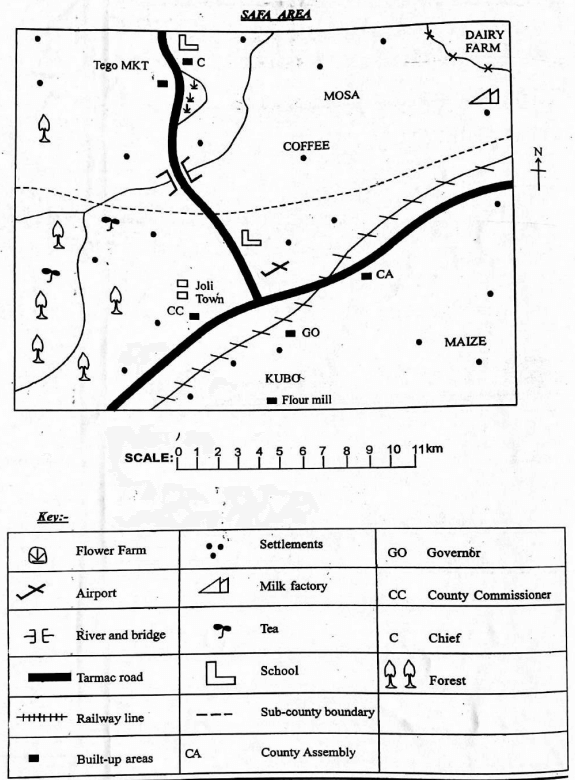
Use the map of Safa area to answer questions 1 - 7.
- Flowers are transported to Joli town for export by
- air
- railway
- water
- road,
- The most senior administrator of Safa area is
- county commissioner
- governor
- chief
- county representaive.
- Which one of the following factors mainly influenced the setting up of the milk factory?
- Nearness to a dairy farm.
- Nearness to market.
- Nearness to a road.
- Availability of space.
- The main contribution of the forest in the Western part of Safa area is that it
- ís a tourist attraction site
- protects the sources of rivers
- is a source of timber
- attracts rainfall in the area.
- The main economic activity carried out in Safa area is
- trading
- farming
- fishing
- lumbering.
- The climate of the area covered by the map can be described as
- cool and dry
- hot and dry
- cool and wet
- hot and wet.
- Land in Safa area generally rises from
- North West to South East.
- South West to North East
- South East to North West.
- North East to South West.
- The main reason why the River and Lake Nilotes dispersed from the Pubungu Pakwach area was
- drought
- famine
- overpopulation
- epidermics.
- Below are statements about marriage system.
- Polygamy is allowed
- It is conducted by a religious leader
- A man can marry only one wife
- A marriage certificate is issued
- It is conducted in a government office
Which one of the following combinations consist of statements that are correct about a Christian marriage?- ii, iii, iv
- i, iv, v
- iii, iv, v
- ii, iv, v
- Africans in Ghana used peaceful means to attain independence because
- Africans had strong leader
- Africans had formed political parties
- most Africans were educated
- the colony did not attract many settlers.
- Which one of the following groups of countries consist of those crossed by the Great North Road?
- Zambia, Tanzania, Ethiopia.
- Congo, Angola, Namibia.
- Kenya, Uganda, Gabon.
- Nigeria, Niger, Algeria.
- South Africa is able to produce many manufactured goods because
- the goods are in great demand
- there is availability of cheap labour
- the country has variety of minerals
- the country experiences high rainfall.
- Below are characteristics of a vegetation zone in Africa
- There are scattered dry shrubs
- Cacti and euphorbia plants are common
- There are dry turfs of grass
The vegetation zone described above is- mediterranean vegetation
- semi-desert vegetation
- tropical vegetatio
- temperate vegetation.
- When the Mandinka people of West Africa resisted French colonial rule they were led by
- Samouri Tour
- King Lewanika
- Chief Mkwawa
- Kabaka Mwanga.
- Below are conditions for growing a certain crop
- Protection from strong winds
- Well drained fertile soils
- High rainfall
- High temperature between 24°c and 27°c
The conditions listed above favour the growing of- wheat
- cotton
- cocoa
- maize.
Use the diagram below to answer question 16
- The type of rainfall shown above is experienced in the following areas except
- Southern Uganda
- Lake Victoria basin
- Coastal lowlands of Kenya
- Central Tanzania.
- Which one of the following groups is made up of Voltaic speakers of West Africa?
- Susu, Mande, Soninke.
- Wolof, Fulani, Tukolor.
- Igbo, Yoruba, Ewe.
- Dagomba, Bergu, Gurba.
- Which pair consists of elements of a map only?
- Key, vegetation.
- Shape, compass.
- Title, frame.
- Relief, drainage.
- Large commercial poultry farming is carried out near urban centres due to
- availability of electricity
- availability of cheap labour
- nearness to market for poultry products
- nearness to source of water.
- Residual mountains are formed through
- erosion
- faulting
- folding
- volcanicity.
- Which one of the following statements about European colonial rule in Belgian Congo is correct?
- Africans were encouraged to assimilate.
- Africans were forced to work in rubber farms.
- Europeans used indirect rule.
- Europeans allowed African chiefs to rule.
- Which one of the following duties is performed by a head teacher in a school?
- Appointing the deputy headteacher.
- Chairing Board of Management.
- Allocating funds to a school.
- Keeping school records.
- Improvement in modern methods of communication has mainly led to
- migration of people to towns
- increase in trading activities
- expansion of urban centres
- expansion of infrastructure.
- Three of the following are ways in which communities interacted in the past. Which one was not?
- Games.
- War.
- Marriage.
- Trading.
- Which one of the following was a contribution of Nelson Mandela? He
- led South Africa to independence
- made South Africa a one-party state
- led South Africa to the first all racial elections
- was a founder member of African Union.
- Lake Tana in Ethiopia and lake Itasy in Madagascar were formed when
- water collected inside faults
- water collected inside craters
- parts of the earth sunk
- flowing magma blocked rivers.
- The Fulani people of West Africa are able to graze their livestock over large areas because
- there is plenty of grass,
- they live in sparsely populated areas
- they keep large herds of livestock
- they use horses to scout for pasture.
- Which one of the following factors may lead to conflicts in the society?
- Use of indigenous languages.
- Intermarriage among communities.
- Unequal distribution of national resources.
- Movement of people to towns.
Use the map of Eastern Africa below to answer questions 29 to 32
- Which one of the following groups of communities used the route marked S during the migration period?
- Abagusii, Abakuria, Abaluhyia.
- Yao, Hehe, Makonde.
- Ngoni, Chagga, Nyamwezi.
- Agikuyu, Aembu, Ameru.
- The main export crop of the country marked Z is
- sisal
- sugarcane
- coffee
- cotton.
- Natural vegetation in the shaded area marked X consist of
- tall elephant grass
- dense evergreen forests
- papyrus reeds
- short dry shrubs.
- Three of the following statements about the town marked T are true. Which one is not?
- It started as an Arab trading centre.
- It is located in a rich agricultural area.
- It is a county headquarter.
- It lies along the Trans African Highway.
- Below are statemens about a type of democracy practised in the society-
- Decisions are made through general agreement
- People are involved in decision making
- People negotiate over issues
The type of democracy described above is- representative democracy
- nominal democracy
- participatory democracy
- direct democracy.
- Which one of the following game parks is correctly matched with the country where it is found?
Game park Country A. Selous South Africa B. Huango Zimbabwe C. Kruger Sudan D. Dinder Tanzania - Which one of the following was a negative effect of colonization?
- Establishment of industries.
- Introduction of cash crops.
- Introduction of modern healthcare.
- Alienation of African land.
- The Ngoni people were forced to move from South Africa by
- Galla
- Zulu
- Arabs
- Bemba.
- Three of the following are contributions of a community to the development of a school. Which one is not?
- Donating land to expand school facilities.
- Providing workers to a school.
- Preparing the school routine.
- Providing resource persons to a school.
- Which one of the following was an achievement of the Organization of African Unity (OAU)?
- It supported countries fighting for independence.
- It established a common trading currency in Africa.
- It promoted the use of a common language.
- It constructed roads in member countries.
- Which one of the following rivers end in the form of an estuary?
- River Omo.
- River Niger.
- River Rufiji.
- River Congo.
- Kelvin is a British national working in Kenya. He can apply for a Kenyan citizenship if he
- marries a Kenyan citizen
- owns property in Kenya
- has lived in Kenya continuously for 7 years
- vies for an elective seat.
- Dairy farming in Kenya is mainly favoured by
- cool and wet highland conditions
- availability of market for milk
- presence of milk factories in farming areas
- availability of good roads to transport milk.
- The diagram below shows the formation of a mountain
Which one of the following mountains in Eastern Africa was formed through the above process?- Mount Ruwenzori.
- Pare highlands.
- Usambara mountains.
- Mount Longonot.
- Which one of the following groups is made up of River and Lake Nilotes found in Eastern Africa?
- Sebei, Pokot, Kalenjin.
- Dinka, Luo, Acholi.
- Samburu, Turkana, Jie.
- Gabbra, Oromo, Burji.
- The Mandinka people of West Africa resisted French colonial rule because
- they wanted to remain independent
- the French stopped them from trading
- they had a strong leader
- they had a well trained army.
- The main product of the planted forests of Swaziland is
- firewood
- pulp
- fruits
- herbal medicine.
- Which one of the following is a function of clan elders in traditional African communities?
- Leading people to war.
- Foretelling future events.
- Allocating land to members.
- Preparing medicine from plants.
- Below are descriptions of an early visitor to Eastern Africa
- He visited Kabaka Mutesa 1 of Buganda
- He explored areas along River Lualaba
- He met David Livingstone
The person described above is- John Speke
- Ludwig Krapf
- Johanne Rebman.
- Henry Morton Stanley.
- African socialism was introduced in Kenya after independence in order to
- settle landless Africans
- promote single party rule
- promote political and economic development
- reward Africans who fought for independence.
- The main reason why cultural artefacts are conserved in museums is to
- preserve the history of communities
- sell them to people who visit the museums
- attract tourists to the country
- create jobs in the country.
- Which one of the following plateaus is correctly matched with the country where it is found?
Plateau Country A. Bie Nigeria B. Fouta Djalon Guinea C. Jos Sudan D. Teiga Angola - Three of the following are effects of industries on the environment. Which one is not?
- Destruction of natural forests.
- Emission of smoke to the atmosphere.
- Settlement of people around industries.
- Dumping of waste in rivers.
- Which one of the following minerals is correctly matched with the method used in extracting it from the ground?
Mineral Method A. Soda ash Evaporation B. Copper Dredging C. Salt Open cast D. Gold Deep shaft - Nabongo Mumia collaborated with the British in Kenya because
- he wanted protection from the Nandi
- he wanted to trade with the British
- he wanted the British to build school
- he wanted to adopt European way of life.
- The settlement of Arabs along the East Coast of Africa led to
- partition of East Africa
- introduction of pastoral farming
- decline in slave trade
- spread of Islam in Eastern Africa.
- The effect of the Benguela currents on the South West Coast of Africa is that it has led to
- growth of dense vegetation along the Coast
- heavy rainfall along the Coast
- dry, conditions along the Coast
- increase of temperature along the Coast.
- Who among the following prominent African leaders was not a founder member of the Organization of African Unity (OAU)?
- Gamal Abdel Nasser.
- Nelson Mandela.
- Leopold Sedar Senghor,
- Haile Sellasie.
- Which one of the following is a responsibility of the government to its citizens?
- Protecting them and their property.
- Establishing places of worship.
- Forming political parties for citizens.
- Campaigning for candidates during elections.
- A Kenyan citizen qualifies to vote if the person
- is able to read
- is a member of a political party
- is a registered voter
- lives in the constituency he is voting.
- The head of a county executive committee is
- a county commissioner
- a senatcr
- a county assembly speaker
- a governor.
- Three of the following statements about a county government are true. Which one is not?
- It is headed by a speaker
- It is headed by an elected leaders
- It implements projects in a county
- It has appointed members.
SECTION B
CHRISTIAN RELIGIOUS EDUCATION
- Which one of the following things did God create on the fourth day?
- Moon.
- Sky.
- Dry land.
- Sea creatures.
- Who among the following people was a son of Noah?
- Seth.
- Shem.
- Lamech.
- Enoch.
- Abraham obeyed God when he was living in Haran by
- taking Lot with him
- accepting to sacrifice Isaac
- getting a wife for Isaac
- moving to an unknown land.
- Moses was not willing to go back to Egypt from Midian because
- he was afraid of the king of Egypt
- his family was in Midian
- the Israelites did not know him
- he was not a good speaker.
- When the Israelites crossed the Red sea they worshipped God by
- singing songs
- offering sacrifices
- reciting the commandments
- fasting.
- Who among the following women was a judge in Israel?
- Ruth.
- Naomi.
- Deborah.
- Hannah.
- Which one of the following was done by David when he was the king of Israel?
- He killed Goliath.
- He built a temple in Jerusalem.
- He made Jerusalem the capital.
- He made the covenant box.
- King Ahab offended God when he
- took Uriah's wife
- took Naboth's vineyard
- planned the murder of Uriah
- consulted a Median.
- Who among the following prophets said that Jesus would be born in the town of Bethlehem?
- Jeremiah.
- Hosea.
- Micah.
- Isaiah.
- Which one of the following events took place when Jesus was born?
- An angel spoke to some shepherds.
- Darkness covered the earth.
- There was an earthquake.
- The curtain in the temple was born. PREDICTOR-001
- When John the baptist met Jesus he called him the
- king of the Jews
- redeemer of Jerusalem
- light to the gentiles
- lamb of God.
- Which one of the following events took place when Jesus was fasting in the wilderness?
- He changed water into wine.
- He was anointed by a sinful woman.
- The devil tempted him.
- He healed a paralyzed man.
- Which one of the following was a teaching of Jesus during the sermon on the mount?
- 'I am the way the truth and life'
- 'Love your enemies and pray for those who persecute you'
- 'Who is the greatest?'
- 'Happy are those who believe without seeing'
- Which one of the following miracles was performed by Jesus in Capernaum?
- Healing a paralyzed man.
- Raising a widow's son.
- Changing water into wine.
- Calming a storm.
- A lesson that Christians learn from the parable of the lost son is to be
- humble
- patience
- repentant
- generous.
- When Jesus was arrested he was praying at
- the Garden of Gethsemane
- the temple in Jerusalem
- the home of Zacchaeus
- the home of Lazarus.
- Peter denied Jesus because
- Jesus had predicted that
- it was at night
- he was afraid of the crowd
- he was not known to the high priest.
- The disciples were filled with the Holy Spirit when they were praying in
- Jericho
- Bethlehem
- Emmaus
- Jerusalem.
- Who among the following believers was chosen as a deacon?
- Ananias.
- Philip.
- Saul.
- Barnabbas.
- Tabitha of Joppa showed kindness by
- making clothes for widows
- giving food to strangers
- washing clothes for the elderly
- feeding orphans.
- Which one of the following groups of books are gospels?
- Ezra, Esther, Job.
- Mark, Luke, John.
- Romans, Ephesians, Jude.
- Revelation, Exodus, Isaiah.
- In traditional African communities children are named after ancestors in order to
- please the parents
- make the children grow healthy
- avoid calamites
- keep the ancestors remembered.
- The work of priests in traditional African communities is to
- lead people in offering sacrifices
- predict future events
- prepare libations
- prepare medicine from plants.
- In traditional African communities children are taught moral values by
- peers
- warriors
- priests
- parents.
- The main reason for marriage in traditional. African communities is to
- get companionship
- get children
- become famous
- get wealth.
- Amos prays for her sick mother. This element of prayer is
- adoration
- petition
- confession
- intercession.
- Christians are encouraged to conserve the environment mainly because
- they get food from the environment
- they are paid to do so
- God has commanded them to do so
- they become known.
- The best way in which parents can teach their children good behaviour is by
- punishing children who misbehave
- rewarding their children
- setting good examples
- taking their children to church.
- Christians preach against abortion mainly because
- it is destruction of life
- it is a waste of money
- it makes people to be disrespected
- it is a waste of time.
- The church has established schools in Kenya in order to
- offer free education
- create jobs in the country
- get money to build churches
- promote literacy in the country.
SECTION B
ISLAMIC RELIGIOUS EDUCATION
- Which prophet of Allah was given Taurat?
- Issa.
- Ibrahim.
- Musa.
- Daud.
- The angel of Allah who brought wahy to the prophets was called
- Jibril.
- Mikail.
- Izrafil:
- Ridhan.
- Which of the following salat does not have rukuu and ujud?
- Witr.
- Janazah.
- Taraweh.
- Tahajud.
- Which one is not a sacred month?
- Rabiul Awwal.
- Muharram.
- Rajab.
- Dhul Qaadah.
- In which month is swalatul tarawih said?
- Rajab.
- Shawal,
- Muharram.
- Ramadhan.
- Which one is not a forbidden animal in Islam?
- The strangled animal.
- The carcasses.
- The animal killed by hunting.
- The animal killed by horns.
- Hiding goods in order to get more profits is called
- ghush.
- hoarding.
- usury.
- ribaa.
- Which rite below is not Umrah?
- Running between swafa and marwa.
- Sleeping at mina and muzdalifa.
- Wearing ihraam.
- Clipping the hair.
- The prophet said that whoever is not thankful to people is not thankful to
- angels.
- the prophets.
- Allah.
- himself.
- In shawwal, it is sunnah to fast _____________________________
- any six days.
- the whole month.
- the first six days.
- the last six days.
- Which of the following is not among the places that were declared safe when makkah was conquered?
- People's own houses.
- The house of Abu Sufyan.
- The holy Kaabah.
- The house of Ikrimah.
- Surah Al-Alaq emphasizes on
- brotherhood.
- peace.
- knowledge.
- last day.
- Which one happened in the battle of Badr?
- The Quraish who taught muslims how to read were forgiven.
- Dead bodies of the Quraish were mutilated.
- The prophet punished Suhail who insulted him.
- Ony those who paid ransom were forgiven.
- Which one is not a pillar of Iman?
- Belief in His angels.
- Belief in paradise.
- Belief in His books.
- Belief in Allah.
- Prophet Muhammad(p.b.u.h) gave His farewell speech on the
- 6th Dhul Hijjah.
- 9th Dhul Hijjah. C
- 10th Dhul Hijjah.
- 5th Dhul Hijjah.
- HIV is not spread through
- sexual intercourse.
- sharing cutting tools.
- blood transfusion.
- shaking hands with infected person.
- Who accompanied Musa to Firaun?
- Harun (A.S)
- His wife.
- Al-Khidr.
- Shuaib (A.S)
- In surah Tiyn, Allah swears by the following except
- Baitul mugaddas.
- Olive tree.
- Mount Sinai.
- Fig tree.
- Who among the following is exempted from fasting?
- The wealthy.
- Men in wet dreams.
- People in Janabah.
- Women in Nijas.
- Which attribute of Allah means the provider?
- Ar-Raham..
- As-Salam.
- Ar.Razaq.
- Ar-Rahim.
- Muhammad (SAW) was appointed the messenger of Allah at the age of
- 25years.
- 40years.
- 30years.
- 63years.
- Which surah of Qur'an is referred to as the mother of Qur'an?
- Alaq.
- Fatiha.
- Ikhlas.
- Nas.
- Salat performed for a dead muslim before burial is known as
- Janazah.
- Kusuf.
- Tahajud.
- Dhuha.
- "Read in the name of your lord, who created" This is a verse from surah
- Fatiha.
- Alaq.
- Ikhlas.
- An-Nas.
- The special prayer performed during the eclipse of the moon is called
- dhuha.
- kusuf.
- istiskai.
- khusuf.
- The fifth pillar of Islam is
- hajj.
- saum.
- kalima.
- salat.
- Who among the following prophets of Allah made the blind to see?
- Musa.
- Ibrahim.
- Shuaib.
- Issa.
- During the journey of Isra wal-miraj, the prophet was given command for muslims to
- go for hajj.
- pray five times.
- fast during Ramadhan.
- give zakat.
- Complete the hadith. "Ritual purity is a sign of ___________________________"
- goodness
- faith
- prayers
- Islam
- Lady Khadija was older than the prophet by
- 20years.
- 10years.
- 15years.
- 40years.
MARKING SCHEME
- D
- A
- A
- B
- B
- C
- D
- C
- A
- D
- A
- C
- B
- A
- C
- D
- D
- C
- C
- A
- B
- D
- B
- A
- C
- D
- B
- C
- B
- C
- D
- A
- C
- B
- D
- A
- C
- A
- D
- C
- A
- D
- B
- A
- B
- C
- D
- C
- A
- B
- C
- D
- A
- D
- C
- B
- A
- C
- D
- A
C.R.E
- A
- B
- D
- D
- A
- C
- C
- B
- C
- A
- D
- C
- B
- A
- C
- A
- C
- D
- B
- A
- B
- D
- A
- D
- B
- D
- C
- C
- A
- D
I.R.E
- C
- A
- B
- A
- D
- C
- B
- B
- C
- A
- D
- C
- A
- B
- B
- D
- A
- A
- D
- C
- B
- B
- A
- B
- D
- A
- D
- B
- B
- A
Science Questions and Answers - Class 8 Opener Exams Term 1 2023 Set 8
QUESTIONS
- A child suffering from anaemia should be fed on food rich in,
- carbohydrates
- calcium
- iron
- proteins.
- Which component of blood transport nutrients to all parts of the body?
- White blood cells.
- Plasma.
- Platelets.
- Red blood cells.
- Tuberculosis is caused by
- bacteria
- virus
- fluke
- germ.
- In which part of the human digestive system does absorption of water and mineral salts occur?
- Small intestines.
- Colon.
- Stomach.
- Rectum.
- To avoid spreading cholera, the person infected should
- observe cleanliness.
- sleep in an isolated place
- exercise to lose weight
- drink alot of water.
- Which one of the following is not a correct statement about male reproductive system?
- Scrotum encloses the testis.
- Epididymis stores sperms.
- Urethra allows urine only out of the body.
- Glands produces fluids.
- The diagram below shows electric cables left sagging when erecting poles and cables.
The main reason for leaving the cables sagging is to- prevent electric shock-
- make them visible
- allow room for expansion
- allow room for contraction.
- Which one of the following vaccines is administered on lower part of left arm of an infant?
- BCG
- DPT
- Anti-polio
- Anti-measles.
- Which animal feed is harvested when it is about to flower and stored in silos when still green?
- Hay.
- Fodder.
- Legumes.
- Silage.
- All the following are physical changes that occurs in adolescent girls only except
- breasts enlarges
- hips broaden
- experiences wet dreams
- experiences menstrual flow.
- Which one of the following is the best weather for washing clothes and winnowing?
- Windy and sunny.
- Sunny and calmy.
- Windy and rainy.
- Calm and windy.
- Which one of the following animals live partly in water and partly on land, have a moist skin without scales and are cold blooded?
- Newt.
- Lizard.
- Chameleon.
- Turtle.
- The following are reasons for preserving food except
- to be available when out of season
- to preserve it from being spoilt
- to reduce wastage
- to make it cheap.
- From the food chain below, tertiary consumers are represented by
Plants → zebra → lion → vulture- Vulture
- Plants
- Lion.
- Zebra.
- Which part of the plant transports food from the leaves to other parts of the plant?
- Root
- Leaf.
- Branch.
- Stem.
- All the following are factors affecting the pitch of a sound except
- length of the material.
- type of material
- thickness of the material
- colour of the material.
- The diagram below represents a home made water filter
Which material is represented by letter X?- Fine sand.
- Charcoal.
- Coarse sand.
- Pebbles.
- Which one of the following is not a way of taking care and maintaining simple tools?
- Proper use of tools.
- Cleaning after use.
- Sharpening all tools.
- Proper storage.
- One of the following pairs consist of field pests. Which one is it?
- Stalkborers and aphids.
- Weaver birds and weevils.
- Rodents and cutworms.
- White-ants and stalkborers:
- Which one of the following is a use of the component that makes up 0.03% of air in the atmosphere?
- Burning.
- Photosynthesis.
- Combustion.
- Germination.
- Which one of the following pairs of processes is as a result of increase in temperature?
- Melting and freezing.
- Freezing and evaporation.
- Evaporation and melting.
- Condensation and freezing.
- The diagram below represents a raingauge
Why is part of the raingauge placed 30cm above the ground? To- prevent water on the ground from splashing into the funnel
- prevent evaporation of collected water
- provide firm support
- withstand the harsh weather conditions.
- Lucerne as a constituent of balanced diet to animals is a source of
- vitamins
- proteins
- carbohydrates
- minerals.
- All the following are reasons why animals move from one place to another except
- to look for food
- to escape harsh weather conditions
- to run away from friends
- to look for shelter.
- The soil that is best in capillarity also
- is best in drainage
- is best in farming
- spreads easily because of it's texture
- used in modelling.
- In which one of the following practices is water re-used?
- Repairing leaking taps and pipes.
- Collecting rain water from the roofs.
- Storing water in dams to use in irrigation.
- Watering plants with water that has been used to wash vegetables in the kitchen.
- Which one of the following groups of food stuffs consists of energy giving foods only?
- Maize, meat, bread.
- Chapati, egg, mango.
- Bread, green bananas, potatoes.
- Green bananas, peas, rice.
- The highness or lowness of sound is called
- pitch
- volume
- mass
- sound amplification.
- The list below consists of sources of light
- Torch
- Sun
- Candle
- Firefly
- Electricity
- Lamp
- Moon
- Glowworm
Which list consists of natural sources only?- i, iv, vi
- vii, ii, iii
- viii, iv, ii
- v, ii, vi,
- All the following are factors that affect sinking and floating of objects except
- type of material
- shape
- weight
- size.
- One of the following is not a safety measure when dealing with electricity. Which one is it?
- By not touching switches with wet hands.
- By not overloading sockets.
- By not sheltering under trees when raining.
- By not putting wires, pencils and even sticks in sockets,
- A ruler inside a glass of water appear bend due to
- refraction
- reflection
- dispersion
- evaporation.
- Class four learners set up the experiment below to investigate a certain aspect of pressure in liquids
What conclusion could the learners make from the set-up?- Pressure in liquids is greatest at the bottom.
- Pressure in liquids is equal at the same depth.
- Pressure in liquids increases with depth.
- Liquids exert pressure in all directions.
- Which method can best be used to separate rice from a mixture of rice and maize?
- Winnowing.
- Sieving.
- Filtering.
- Decanting.
- Which weed has purple and white flowers, yellow fruits and sharp thorns in the stem and leaves?
- Pigweed.
- Sodom apple.
- Wandering jew.
- Mexican marigold.
- Which one of the following pairs consists of external animal parasites only?
- Roundworm and hookworm.
- Fleas and tsetse flies..
- Liverflukes and ticks.
- Fleas and tapeworm.
- All the following are major components of environment.except
- water
- animals
- light
- air.
- The diagram below shows a flower
In which of the labelled parts of a flower does the process of germination of pollen grains take place?- X
- Y
- O
- P
- The following are effects of force except
- increase speed
- stop objects
- start motion
- change state of matter.
- Which type of soil erosion causes landslides, not easily noticed and occurs on gentle slopes?
- Rill.
- Sheet.
- Gulley.
- Splash.
- Which one of the following is not an importance of water in a diet?
- Helps in getting rid of waste products.
- Helps in making blood.
- Helps in digestion.
- Helps in provision of proteins.
- The planet that has visible rings around it is called
- Saturn
- Mercury
- Venus
- Jupiter.
- All the following are sources of electricity except
- georthermal generators
- solar energy
- bulb
- bicycle dynamo.
- The diagram below represents a lever
Which one of the following shows the correct names of part L, Q and P?- Pivot, load, effort.
- Fulcrum, effort, load.
- Effort, pivot, load.
- Load, fulcrum, effort.
- The main reason why coloured water is used in the construction of a liquid thermometer is to
- increase its density
- increase its expansion
- make it visible
- make it absorb more heat.
- Which of the following lists consists of non-magnetic materials only?
- Cobalt, copper, silver.
- Zinc, brass, aluminium.
- Silver, chromium, alinico.
- Brass, copper, tin.
- All the following are advantages of friction except
- sharpening
- erasing
- produces unwanted heat
- walking.
- When choosing a method of separating a mixture of a liquid and a solid it is important to consider the
- density of the liquid
- weight of the solid
- solubility of the.solid
- size of particles of solid.
- Which one of the following best describe the term environment?
- The home of a human being.
- Land and atmosphere.
- The surrounding of a living thing.
- Living animals and plants.
- Three of the following are main parts of a sperm except
- tail
- head
- nucleus
- ovary.
MARKING SCHEME
- C
- D
- A
- B
- A
- C
- D
- A
- D
- C
- A
- A
- D
- A
- D
- D
- B
- C
- A
- B
- C
- A
- B
- C
- D
- D
- C
- A
- C
- D
- C
- A
- D
- B
- B
- B
- C
- A
- D
- B
- D
- A
- C
- C
- C
- B
- C
- D
- C
- D
Kiswahili Questions and Answers - Class 8 Opener Exams Term 1 2023 Set 8
Soma vifungu vifuatavyo. Vina nafasi 1 mpaka 15. Kwa kila nafasi umepewa majibu manne hapo. Chagua jibu lifaalo zaidi kati va vale uliyopewa
Sikukuu ya Krismasi ilishangiliwa __1__. Makundi ya wakristo __2__ makanisani ili __3__. Ndugu na jamaa __4__ waliziwahi sehemu__5__ burudani ili kuburudika kwa furaha na buraha. Watu wengine __6__ ili kuwapa mkono waliokuwa hawajiwezi __7__
walizingatia kwamba __8__.
| A. | B. | C. | D. | |
| 1. | kwa hamu na ghamu | kwa uti wala mauti | kwa shangwe na nderemo | kwa udi na uvumba |
| 2. | walimiminika | yalimiminika | watamiminika | yatamiminika |
| 3. | kusheherekea | kushehekea | kureshehekea | kusherehekea |
| 4. | pia | ilhali | madhali | angalau |
| 5. | ya | kwa | za | wa |
| 6. | walijitolea kibwebwe | walijitolea mhanga | walijitolea kingoto | walijitolea kiguu |
| 7. | Kwa kwamba | kwa ajili | Kwa hakika | Kwa moja |
| 8. | kutoa ni moyo, usambe ni utajiri | cha mfupi huliwa na mrefu | mtegemea cha nduguye hufa maskini | fimbo ya mbali haiui nyoka |
Kiswahili ni lugha mojawapo __9__ katika mazungumzo ya kawaida. Lugha hii __10__ sana __11__ nyanja anuwai. Wanafunzi shuleni hufundishwa __12__ thelathini.
Aidha, kuna sauti ghuna ambazo pia huitwa __13__. Sauti hizi huunda __14__. Mathalani, neno 'kilichoundwa' lina silabi __15__
| A | B | C | D | |
| 9. | zilizotumika | iliyotumika | zinazotumika | inayotumika |
| 10. | inadhaminiwa | kinathaminiwa | inathaminiwa | kinadhaminiwa |
| 11. | katika | kati ya | kwenye | katikati ya |
| 12. | konsonati | alfabeti | vokali | irabu |
| 13. | nyepesi | sighuna | kwaruzo | mwambatano |
| 14. | neno | sentensi | silabi | aya |
| 15. | sita | tano | kumi na mbili | nane |
Kutoka swali la 16-30. jibu swali kulingana maagizo uliyopewa.
- Chagua matumizi ya 'kwa' kurejelea mchanganyiko
- Walitembea kwa miguu hadi shuleni.
- Wazee kwa vijana walihudhuria sherehe hizo.
- Timu hizo zilifungana mabao matano kwa sita.
- Aliadhibiwakva utundu wake.
- Hazama ni kwa puani kama vile _________________________ ni kwa sikio.
- mkufu
- kidani
- kipete
- mapete
- Chagua wingi wa sentensi hii
Ua wa dobi ulinivutia sana- Maua ya madobi yalituvutia sana.
- Nyua za madobi zilinivutia sana.
- Maua ya dobi yalituvutia sana.
- Nyua za madobi zilituvutia sana.
- Chagua kiambishi 'ku' cha ukanusho
- Kusoma huku kunafurahisha
- Hakusoma kitabu hicho cha hadithi
- Aliyekupiga ametiwa mbaroni
- Mchezo huo ulichezwa kule.
- Fidia ni _______________________
- malipo ya kumvunjia mtu heshima
- malipo ya kwanza ya kumshika mtoto
- malipo kwa ajili ya hasara au maumivu
- malipo ya kwanza ya kukinunua kitu dukani.
- Kanusha:
Jengo lililojengwa kwa uhafifu limebomolewa- Jengo lisilojengwa kwa uhafifu limebomolewa
- Jengo lililojengwa kwa uhafifu halijabomolewa
- Jengo halikujengwa kwa uhafifu limebomolewa
- Jengo lisilojengwa kwa uhafifu halijabomolewa.
- Ni nini maana ya msemo huu?
Kumvisha mtu kilemba cha ukoka- Kumtegemea mtu kwa kila jambo.
- Kumsema mtu katika mafumbo.
- Kumweka mtu katika hatari.
- Kumdanganya mtu kumhusu.
- Chagua jibu lenye ala za muziki pekee
- Filimbi, udi, mvukuto, chapuo.
- Siwa, zeze, upatu, nembo.
- Njuga, tari, kinubi, fidla.
- Harimuni, marimba, msondo, maleba.
- 5/6 kwa maneno ni
- sudusi sita
- humusi sita
- sudusi tano
- humusi tano.
- Ni kundi lipi la nomino ambalo lipo katika ngeli ya LI-YA?
- Maji, marashi.
- Gitaa, povu.
- Maskani, mavazi.
- Maagizo, maarifa.
- Onyesha sentensi yenye kielezi cha mahali
- Mwajuma alisafisha nyumba alfajiri.
- Kule kuna miti mirefu.
- Wawili walisajiliwa chuoni.
- Gari limefika asubuhi.
- Chagua jibu lenye nomino ya makundi isiyofaa
- Mzengwe wa wagomaji.
- Numbi ya nyuki.
- Shungi la moto.
- Thurea ya nyota.
- Kauli, 'Jedi ni sungura maishani; imetumia tamathali gani ya usemi?
- Jazanda.
- Kinaya.
- Tashhisi.
- Nahau.
- Ikiwa juzi ilikuwa Jumanne, mtondo itakuwa
- Ijumaa.
- Jumatatu.
- Jumapili.
- Jumamosi.
- Chagua jibu lenye kivumishi kilichoundwa kutokana na kitenzi.
- Ita - mwito
- Vumilia - uvumilivu
- Agiza - maagizo
- Sahau - sahaulifu.
Soma kifungu kifuatacho kisha ujibu maswali 31 - 40.
Kuku aliketi nje ya nyumba yake huku amejishika tama. Moyo wake ulijawa na huzuni mpwitopwito. Je, angewezaje kuujenga urafiki wake upya na mwewe mwandani wake wa chanda na pete? Tatizo sugu lililokuwa limeubomoa urafiki wao wa kufa kuzikana ni wembe. Kuku alishangaa namna ambavyo kitu kidogo kama hicho kingesababisha mgogoro kama huo mkubwa. Mawazo kedekede
yalizidi kumzunguka akilini mithili ya pia.
Mwewe naye kwa upande wake pale kiotani alitabasamu kwa furaha mzomzo. Aliurarua mnofu wa nyama wake kifaranga mtoto wa kuku. Kwake alijiambia kuwa, "Sasa ninazidi kujilipa deni langu la wembe. Mtu hawezi kuwa ananipotezea rasilimali zangu pasipo kuzingatia hisia zangu pia. Bado atakuja kunitambua! Atabaki mzazi bila vikembe hadi atakapolipa deni lote!"
Giza la usiku lilikumbatia siku yenyewe. Sauti za mbwa zikawa zinasikika kwa umbali. Bado kuku pamoja na vifaranga wake watatu walikuwa hawajalala. Biwi la simanzi liliwaangukia kuku. Mtoto wake wa kiume alikuwa amenyakuliwa na mwewe. Mwewe asiye na utu wala msamaha. Mbona asingengoja hata siku moja imalizike kabla ya kuanza kujilipa yeye mwenyewe? Kwa nini basi asingekuja wapange mikakati namna ya kulipwa? Utitiri wa mawazo ulimtembea akilini mwake bighairi ya kuwa na mwisho.
Hatimaye, kuku aliwageukia wana wake ambao ndio chanzo cha kupotea kwa wembe wake mwewe. Aghalabu, alikuwa amewakanya dhidi ya kuchezea vitu vya wenyewe bila ya ruhusa. Kuku alijua siku moja mchezo wao huo ungewatumbukiza katika kidimbwi cha moto. Sasa moto huo ulikuwa umeanza kuwateketeza mno. Kuku akaishia laiti ningalijua na vyanda vi mkononi. Hata hivyo, akaamua
kulitafuta suluhisho la kudumu ifikapo asubuhi.
Jua la asubuhi liliramba umande wa alfajiri huku likimzizimua kobe ambaye alitoka nyumbani mwake asteaste. Mzee kobe alisifika sana kwa maarifa yake na akili tambuzi alizokuwa nazo hasa katika kuyatatua mambo baina ya wenzake. Aliketi pale nje huku akibukua tabu kubwa kuhusu migogoro. Kuku jirani yake aliwasili kwake kwa kishindo. Hapo kobe akatambua ya kwamba lazima kuna jambo. Huku amenyong'onyea kama mkufu. Kuku alimpasulia mbarika mzee kobe kuhusu tatizo lake.
Jungu kuu halikosi ukoko. Baada ya kikao hicho cha saa tatu naye mzee kobe, kuku alirudi nyumbani akiwa na matumaini kwamba suluhu limepatikana. Mzee kobe alibaki katika kina kirefu cha fikra ili kulipata suluhisho hilo la kudumu na kumpiga jeki jirani yake. Kwa hakika, ni heri jirani kuliko ndugu yako wa toka nitoke wa mbali.
- Chagua maana ya 'kushika tama' kwa mujibu wa kifungu.
- kuhangaika
- kuhuzunika
- kunung'unika
- kukasirika
- Kulingana na aya ya kwanza, kuku
- aliketi ndani ya kiambo chake
- alikuwa jasiri na mkakamavu
- aliwazia kiini cha ufa uliokuwa umetokea
- hakushangaa kiini cha mgogoro.
- Kulingana na aya ya pili, mwewe anaonekana kuwa
- mwenye ubinafsi
- mwenye urafiki wa dhati
- mwenye huzuni nyingi
- mwenye maarifa chungu nzima.
- Kitendo cha mwewe kuamua kujilipishia deni lake kinaweza kulinganishwa na methali gani?
- Asante ya punda ni mateke.
- Tamaa mbele mauti nyuma.
- Mtu ni watu.
- Uzuri wa mkakasi ndani kipande cha mti.
- "Biwi la simanzi lilimwangukia kuku,"
imetumia tamathali gani ya usemi?- Ishara.
- Sitiari.
- Chuku.
- Tashhisi.
- Kwa nini mzee kobe alisifika?
- Kwa sababu alipenda kusoma mabuku.
- Kwa sababu alikuwa mstahimilivu.
- Kwa sababu alikuwa mwenye akili pevu.
- Kwa sababu alipenda kuliota jua.
- Kulingana na aya ya mwisho si sahihi kusema
- kikao hakikuzalisha matunda.
- jirani anaonekana kuwa na umuhimu.
- mzee Kobe aliwazia jambo hilo.
- kikao kilichukua saa tatu.
- Kifungu kinabainisha kwamba
- mwewe alikuwa mwandani wa dhati.
- kuku hakuwajali watoto wake.
- mzee kobe hakupenda kisomo kwa dhati.
- kuku alimwelezea kobe mambo dhahiri.
- Maana ya, "biwi la simanzi' kulingana na kifungu ni
- mkusanyiko wa hasira
- mkusanyiko wa taka
- kuwa na kiasi kikubwa cha huzuni
- kuwa na kiasi kikubwa cha taka.
- Kichwa kifaacho kifungu hiki ni sana ni
- Mzee Kobe mwenye magamba.
- Elimu nyingi huondoa maarifa.
- Urafiki wenye unafiki.
- Vifaranga vya kompyuta.
Soma kifungu kifuatacho kisha ujibu maswali 41 - 50.
Afya au siha ni hali ya kutokuwa na maradhi. Hali hii humwezesha mtu kuhifadhi nguvu zake za mwili na kumwezesha kufanya kazi katika mawanda mbalimbali. Mtu mwenye afya bora huweza kutekeleza mengi bila masumbuko. Kwa mfano, yeye huweza kujirausha na kujishughulisha hadi jioni bila kuhisi uchovu mwingi.
Chombo hakiendi ila kwa makasia, nayo afya nzuri haimjii tu mtu. Afya hustahili kupaliliwa na kutunzwa kwa namna anuwai kama vile kula vyakula vyenye viinilishe, kufanya mazoezi na kuandama mienendo miadilifu. Usafi wa mv ili na mazingira pia huchangika katika kuimarisha afya. Ni bayana kwamba mazingira yakiwa machafu hukosa kuvutia na kusababisha kusambaa kwa harufu inayokirihisha. Isitoshe, uchafu huwa hali mufti ya kuzaana kwa wadudu kama vile chawa, nzi, kunguni na mbu ambao ni maadui wakuu wa afya.
Tabia ya binadamu huathiri afya yake. Wapo watu ambao wameambulia magonjwa kama vile saratani ya mapafu na kifua kikuu kutokana na mazoea ya pombe, sigara na dawa za kulevya. Wengine hujiponza kwa kuingilia vitendo viovų kama vile kushiriki mapenzi kiholela na kujisababishia magonjwa. Magonjwa haya ni kama vile kisonono na ukimwi ambao umewapukutisha watu kama majani makovu kutoka mtini.
Aidha, watu hujiharibia afya kwa kufanya kazi mfululizo bila kupumzika. Licha ya kwamba bidii ni muhimu katika maendeleo ya jamii yoyote ile, utendaji kazi pasipo kupumzika huweza kuwa na athari hasi. Kuna baadhi ya watu ambao wamewahi kupata maradhi ya moyo, ya kiakili na hata shinikizo la damu kutokana na hali kama hii. Wengine hujihasiri kwa kula vyakula vingi kupindukia. Kadhalika, wapo wengine ambao hupata magonjwa kwa kula vyakula visivyofaa katika kundi hili kwa wale ambao hawadiriki kufanya kazi wala mazoezi. Hawa hujinenepea na kudhoofisha utendakazi wao.
Hali ya umaskini pia huchochea kuzoroteka kwa afya. Asilimia kubwa ya watu nchini humu haimudu huduma bora za afya na lishe bora kutokana na hali ya ufukara. Wengine, kwa kukosa fedha hawapati elimu ya kimsingi kuhusu afya. Hawa huweza kujizulia magonjwa kwa kutojua na kutofuata sheria za afya. Pamoja na hayo, kuna wale ambao wanarithi magonjwa ya kiukoo kama vile bolisukari kutoka kwa wazazi wao.
Umuhimu wa afya hauwezi kupuuzwa. Nchi yenye kizazi chenye afya hustawi kiuchumi. Afya ikidumishwa wanajamii huweza kutumia fedha zao kuwekeza katika miradi badala ya kuzitumia kujiunga na kuwauguza wenzao. Ni jukumu la kila raia kuhakikisha kwamba anailinda afya yake na ya wengine kwa vyovyote vile. Walio na mazoea ya kupuuza ushauri wa wanaotoa huduma za afya na lishe wajiase, la sivyo watakuja kujiuma vidole.
- Kulingana na aya ya kwanza siha
- hukuza maendeleo katika maeneo mbalimbali
- humwondolea mtu matatizo mwilini
- humpunguzia mtu mazoea ya uchovu
- huimarisha matokeo ya utendakazi.
- Ni muhimu kutunza mazingira kwa kuwa
- tutamaliza vikwazo tofauti tofauti vya afya
- tutazuia ongezeko la wadudu waharibifu
- tutaepuka kuenea kwa harufu
- tutarudisha hali ya kupendeza.
- Mwandishi anapinga hali gani hasa katika aya ya tatu?
- Uambukizaji wa magonjwa.
- Kuhusiana bila mpango.
- Vifo vya watu wengi.
- Matumizi mabaya ya mihadarati.
- Chagua jibu ambalo ni sahihi kulingana na aya ya nne
- Jambo jema husababisha maradhi
- Kazi nyingi husababisha moyo kuharibika
- Mazoezi hayawezi kudhibiti afya.
- Mapumziko huimarisha hali ya mtu kiakili.
- Kufanya kazi kidindia
- huboresha maendeleo ya taifa
- huweza kusababisha uharibifu wa afya
- huwa na athari chanya
- hupunguza shinikizo la damu.
- Maana ya 'inayokirihisha' ni
- inayochukiza
- inayoenea
- inayoaibisha
- inayodhuru.
- Maana ya "chombo hakiendi bila ya makasia' imejitokeza vipi katika kifungu?
- Wanaonyoosha viungo vyao huwa wakakamavu.
- Wanaozingatia mienendo mizuri hudumisha afya.
- Wanaoepuka kazi hawapati shinikizo la damu
- Wanaokula vyakula vyenye viinilishe huzuia kunenepa.
- Chagua funzo linalojitokeza katika aya ya mwisho
- Wanaokosa kuzingatia maelekezi hupata majuto.
- Mtu hawezi kufaidika kiafya bila kupata ushauri.
- Wanaodharau watu wenye hekima hupata magonjwa.
- Nchi haiwezi kupiga hatua bila raia wote kuzingatia maradhi.
- Umuhimu wa afya hauwezi kupuuzwa kwa vile
- mipango nchini hukwama wahudumu wakikosekana
- watu wagonjwa hawawezi kuizalisha mali
- maradhi husababisha kuzorota kwa maendeleo
- pesa nyingi hutumiwa kuwatunza walio hospitalini.
- Kisawe cha 'kujiuma vidole" ni
- kupiga vijembe
- kutia nanga.
- kupigwa butwaa.
- kujuta hatimaye.
INSHA
Una dakika 40 kuandika insha yako
Andika insha ya kusisimua ukiendeleza kwa maneno haya:
Nilikuwa nimeketi sebuleni nikisoma kitabu cha hadithi.........
MARKING SCHEME
- C
- B
- D
- A
- C
- B
- C
- A
- D
- C
- A
- B
- C
- C
- B
- B
- D
- D
- B
- C
- B
- D
- C
- C
- B
- C
- B
- A
- C
- D
- B
- C
- A
- D
- D
- C
- A
- D
- C
- C
- D
- A
- D
- D
- B
- A
- B
- A
- C
- D
English Questions and Answers - Class 8 Opener Exams Term 1 2023 Set 8
The passage below contains blank spaces 1 - 15. Read and select the best alternative for each blank space from the choices given.
Our lives are shaped by the countless decisions we __1__ everyday. Every previous decision we made before this very moment shaped our life up till now. Right now, the decision to read this or not __2__ shape your thinking one way or the other.
Last night I had to make a decision between __3__ a party where I will meet my friends versus staying __4__ home to finish up all the work that pilled up when I was sick past few days. Everyday, we make decisions. Big, small __5__ seemingly insignificant decisions. These major decisons at different milestones of our __6__ can change the way we live for the rest of our lives. But we __7__ ignore the countless "insignificant" decisions we make daily that are slowly nudging us to a different path either away __8__ closer to the dreams we __9__ to achieve.
When we decide to watch some T.V-show, we are deciding to take time away from __10__ else we dream of doing. May be its losing weight or learning a new language. You are taking time away from that goal when watching T.V. Life could change__11__if decision is made otherwise.
We make decisions based __12__ the mental compasses that we have in our minds. They point us to a __13__ direction. These compasses help in making decisions subconsciously. As a life-longs learner, one won't think about not watching drama, before simply switching to an educational __14__ without much thoughts. Some people live without a mental compass. They are like jellyfish in the ocean, floating to wherever the current takes __15__ Not a so good character to possess.
| A | B | C | D | |
| 1. | produce | attempt | make | decide |
| 2. | may | can | will | shall |
| 3. | attending | controlling | showcasing | cancelling |
| 4. | for | in | with | at |
| 5. | but | and | hence | nevertheless |
| 6. | live | life | leave | lief |
| 7. | rarely | never | seldom | often |
| 8. | or | nor | none | neither |
| 9. | need | stop | want | opt |
| 10. | whomever | whatever | whichever | whoever |
| 11. | cause | coarse | coast | course |
| 12. | on | by | through | into |
| 13. | certain | crowded | believed | reserved |
| 14. | resources | instruction | channel | current |
| 15. | him | them | her | their |
For questions 16 and 17, select the word which best completes the sentence given.
- All the interviewees answered the questions _____________________ during the interview.
- anyhowly
- anyway
- in any case
- anyhow
- The army soldiers sustained gunshot ______________________in the battle field.
- injuries
- damages
- wounds
- breakages
For questions 18 and 19, choose the alternative that can replace the underlined
- Paulo broke down when he received news that an accident had occured.
- cried
- collapsed
- crashed
- cringed
- She seldom talks to strangers happily when they meet.
- never
- rarely
- often
- always.
In questions 20 and 21, choose the phrase which completes the given phrase appropriately.
- The mechanic said that the bus won't start
- when a new battery is fixed
- until a new battery is fixed
- for a new battery is fixed
- because a new battery is fixed.
- It would have been an interesting trip if
- we visited Mombasa
- we had visited Mombasa
- we will visit Mombasa
- we would visit Mombasa.
For questions 22 and 23, fill the blank spaces with the correct answers.
- Our teacher was upset because we had made ____________________ progress in the project.
- a little
- much
- few
- little
- Each candidate will be rewarded for posting _____________________ performance in the test.
- exemplary
- diminishing
- accomplishing
- culinary
For question 24, change the sentence below from active voice to passive voice.
- Anita is going to sing a song
- A song was sung.
- Anita sang a song.
- A song is being sung.
- A song is going to be sung.
For question 25, choose the sentence with the correct punctuation.
-
- 'Clean the house' Nelly told Martin.
- The teacher asked her where she had been?
- Kashu is born of a well-to-do family.
- What an expensive garment?
Read the passage below and answer questions 26 - 38.
Nothing seemed ordinary as an array of silent wind blew around. Fear crept into Mwendwa. Was this real or some sort of imagination? His heart nearly leapt into his mouth when he saw a silhouette of a huge man. A close-keen look proved to him that it was nothing but a tree.
The thought of breaking into a run to save his dear life crossed his mind but his feet were too feeble to move even an inch. His squinted eyes toured from corner to corner trying to unravel the source of the weird noise.
Flooded in fear, Mwendwa stammered an inaudible prayer; something which he had never done from time immemorial. Fervently, he tried calling all the spiritual beings he had ever heard about. However, one thing was crystal-clear, they had better and more 'serious' matters to attend to. In great fear, he broke into a run hoping against hope to atleast salvage his dear life. It was very evident that lady luck was without a doubt not on his side, probably the god's were against him. He quickly tiptoed on a loop and feli face flat. To rub salt to injury, he sustained a deep cut which made him to bleed heavily. As if that was not enough, he had ripped off his short.
Writhing in pain, he leapt off the mucky ground. It was foolish to labour his mind over such a mere thing. Come what may, he had to put up a fight and see another day. Mwendwa knew he had not a single soul on his side not even the Almighty Deity after all his mischief; he had no one to depend on.
He shed teardrops in bitterness and remorse mourning like he had never done before. If actions could be undone then pressing the 'undo' button would have been the best option but if wishes were horses, beggars would ride. A look into the clear sky spelt doom for Mwendwa for he had been far away from home. His family members would be left in shock after learning where he was; no company or even a mobile phone. Nothing of such kind had ever happened to them, for any reason whatsoever.
The rustling of leaves under his feet brought him back to reality. He had to quickly formulate a plan which would see him escape his immediate predicaments. Through thick and thin he had to survive and live to tell the tale if anyone cared to listen. A continued run into an alien place was riddled with the option of no trace but remaining alive was a very slim chance. In the recent days, there had been numerous complains of how difficult it had become to put food on the table. Worse still was the opportunity for Mwendwa getting employed despite being a minor. Nobody would risk it. At the same time, hunger pangs were making his belly to feel uncomfortable. Not even some wild berries would be spotted in sight to quench his starving body. He made a big yawn before proceeding with his journey which only God knew where to.
A clear stream of mountain waters gave Mwendwa a reason to believe that he would actually survive. He knelt down and drank to his fill straight from the stream. All this while he was so grateful to have come across it. He also opted to wash his dry face and dusty feet before marching on. The sun was setting fast when he came across a dusty, abandoned road. He clearly felt that his body was giving in pretty fast. Any nearby person would have helped him but there was none in sight.
With a thud, his mass of body collapsed right away on the side of the road. He was gone, not sure whether he would walk on earth again. After seemingly having had been in deep slumber, Mwendwa came to only to find a young lady with a stethoscope standing next to him. He smiled at her and she did smile back assuring him that he was alive and in the hospital. No family member was in sight but the nurse informed him that they had spent the previous night watching over him and that they had rushed back home before coming back during visiting hours.
The nurse asked him to rest and that they would talk at a later time. Mwendwa obliged though not knowing how he would explain his disappearance as well as his action.
- From the first paragraph, what actual thing had scared Mwendwa?
- A huge man.
- A tree.
- Blowing wind.
- His imagination.
- According to the passage, what had led to Mwendwa's short getting torn?
- He was bleeding profusely.
- He had fallen down.
- He was held by thorns.
- He was struggling to save his life.
- Through thick and thin as used in the passage means that
- very extensive moments
- extremely fatigued
- under all circumstances
- really ordinary times.
- From the passage, what would make it difficult for Mwendwa to get employed?
- He was underage.
- He had never worked before.
- He was far away from home.
- He was extremely hungry.
- The writer say that 'the clear sky spelt doom'. This means that
- he had given up
- he was being followed
- he prayed for help
- he was far from home.
- How did Mwendwa feel after coming across the clear stream?
- He was confused.
- He was shocked.
- He was remorseful.
- He was thankful.
- Who did Mwendwa see first after regaining consciousness?
- Family members.
- Teacher.
- Nurse.
- Neighbour.
- Why did Mwendwa feel that he was all by himself?
- Because of fear.
- Because of his misdeeds.
- Because he saw a huge man.
- Because of his imagination.
- What tells that Mwendwa was not a prayerful boy?
- It was long before he prayed.
- The god's were busy.
- He believed in spiritual beings.
- He wasn't going to church.
- The word 'minor' has been used in the passage. Which word means its opposite as used in the passage?
- Adult.
- Major.
- Important.
- Small.
- Why was Mwendwa's body giving in very fast?
- He was thirsty.
- He was exhausted.
- He was starving.
- He had collapsed.
- Which of the sentences below does not describe the place where Mwendwa was found lying?
- The road was lonely.
- The place was filled with dust.
- There was a nearby stream.
- There was a thud.
- Which of the following would be the most suitable title for this passage?
- Mwendwa cheats death.
- Pride comes before a fall.
- The nurse who carried a second life.
- Life in the woods.
Read the passage below and answer questions 39 - 50.
As the largest of all land mammals, African elephants play an important role in balancing nature. They trample forests and dense grasslands, making room for smaller species to co-exist. Elephants also create water holes used by other wildlife as they dig dry riverbeds when rainfall is low. Herds travel over vast grasslands and they disperse seeds in their dung, which helps generate new green growth. But threats to this giant of the forest are numerous. African elephants are most threatened by the poaching crisis. A great number is killed every year for their tusks; the natural growth rate in most elephant populations has yet to overtake the rate of killings. Many elephants are also the victims of retaliatory attacks after they venture into human settlement and farm areas.
Meanwhile, climate change and human land use are degrading wild lands, breaking up essential elephant habitats and impending ancient migratory corridors. With the growth of commercial agriculture and infrastructure development, as well as extractive industry across the continent, the future of this species is at risk.
To reserve the drastic decline and secure natural habitats, a deliberate effort to protect the ecosystem is needed. Conservation work should extend across a range of states, including Benin, Botswana, Cameroon, Democratic Republic of Congo, Kenya, Tanzania, Zambia and Zimbabwe. Identified priority landscapes- some spanning thousands of kilometres across countries are under watch. Provision of wildlife rangers and community scouts with the skills and equipment is needed to prevent the illegal killing of this keystone species.
At the same time, working with local communities and landowners to minimize habitat loss caused by unsustainable farming and overgrazing is an ideal thing to do. The training of farming communities in conservation-friendly agriculture and creating land-use plans with communities that might otherwise encroach on critical wildlife corridors outside protected areas is recommended.
The Amboseli is a vital elephant stronghold and popular tourist destination in East Africa. The community created conservancies to secure more space for elephants and other wildlife species. On these communal lands there is provision of an alternative livelihood for pastoralist groups using wildlife corridors as grazing land. By building the technical capacity of wildlife protection, rangers on the ground has strengthened monitoring systems that track threats across vast landscapes. Ranger training and provision of monitoring equipment patrol teams have destroyed uncountable poaching camps, arrested the poachers and confisticated elephant tusks and firearms.
However, catching poachers is only half the battle. Training and deployment of sniffer dog units at strategic ports of entry and exit has helped to deter trafficking and catch smugglers. Without effective prosecution, wildlife offenders can evade punishment-and worse still, continue to engage in crime against elephants. Prosecutors and law enforcers offer effective wildlife crime investigation and prosecution.
In Tsavo which stretches across Kenya and Tanzania, cross-border coordination between anti-poaching units and wildlife law enforcement units has continued to deliver the much needed impact. Aerial widlife count shows that elephant population has increased tremendously. In addition to the growth of elephant population, buffalo and giraffe populations have increased. However, some elephant carcasses were spotted. This is a reminder that the elephant species is under constant threat from habitat loss, human-wildlife conflict and poaching for its ivory..
- Where are elephants most likely to be found in Africa?
- On grasslands and forests.
- On mountains and grasslands.
- On sparse grasslands only.
- On the savanna and plateaus.
- Which of the below would secure natural habitats?
- Development of infrastructure.
- Provision of 24-hour security.
- Conservation efforts.
- Proper land scaping.
- What is the main reason why elephants are killed?
- Because of destroying vegetation.
- Because of food demand by other animals.
- Because of their tusks.
- Because of their high population.
- The word popular has been used in the passage.Which word can be used in its place?
- Famous.
- Enjoyed.
- Fashionable.
- Liked.
- Which of the below is making elephants to change their migratory routes?
- Human land disuse.
- Climatic changes.
- Few wild lands.
- Lack of enough pasture.
- What has led to destruction of poaching camps?
- Lack of forest cover.
- Death of elephants.
- Rangers training.
- Provision of firearms.
- Which of the below countries is Tsavo found?
- Tanzania.
- Botswana.
- Zimbabwe.
- Cameroon.
- What do you think has been used to establish the actual population of elephants?
- Trucks.
- Aeroplane.
- Survey.
- Monitors.
- It is true to state that
- farm areas are near forests
- wildlife crime investigation is slow
- sniffer dogs are placed at exits only
- killed elephants are more than those born.
- Which animal has not benefited from the conservation efforts?
- Buffaloes.
- Elephants.
- Giraffes.
- Gazelles.
- Who is responsible for the prevention of illegal killing of animals?
- Community scouts.
- Poachers.
- Prosecutors.
- Police officers.
- Choose the appropriate title for the above. passage?
- The extinction of African elephants.
- Elephants' support of Africa's ecosystem.
- Poaching and its effects.
- The real value of ivory.
COMPOSITION
Write a composition starting with the following sentence. Make your work as interesting as possible
Schools had just opened and the lessons had started off well. Everything changed when we heard the bell ring .................................
MARKING SCHEME
- C
- C
- A
- D
- B
- B
- D
- A
- C
- B
- D
- A
- A
- C
- B
- D
- C
- A
- B
- B
- B
- D
- A
- D
- C
- B
- B
- C
- A
- D
- D
- C
- B
- A
- A
- C
- D
- A
- A
- C
- C
- D
- B
- C
- A
- B
- D
- D
- A
- B
Mathematics Questions and Answers - Class 8 Opener Exams Term 1 2023 Set 8
QUESTIONS
- What is 60203303 in words?
- Sixty million two hundred and three thousand three hundred and three.
- Six million two hundred and three thousand three hundred and three.
- Sixty million twenty three thousand three hundred and three.
- Sixty million two hundred and three thousand three hundred and thirty three.
- How many times is the LCM of 60 and 20 more than the GCD of 15 and 30?
- 12
- 900
- 4
- 600
- What is the value of:
0.81 × 13.5 × 0.56 ?
0.14 x 1.5 x 0.27- 1080
- 108
- 10.8
- 1.08
- What is 36090 divided by 18?
- 25
- 205
- 200.5
- 2005
- The figure below shows a square whose perimeter is 64cm.
What is the area of the square?- 16cm2
- 225cm2
- 256cm2
- 15cm2
- What is the next number in the pattern
7, 11, 13, 17, 19, _______________?- 21
- 23
- 27
- 25
- What is the value of 71/2 of 7/9 ÷ 161/3 ?
- 5/14
- 24/5
- 15/42
- 955/18
- Fifteen people can complete some work in 50days. How many more people working at the same rate are required to do the work in 25days?
- 30
- 45
- 15
- 25
- The ages in years of seven of Juliana's relatives are as follows 45, 38, 43, 43, 39, 40 and 39. What is their mean age?
- 38
- 43
- 40
- 41
- The figure below represents a trapezium.
Calculate its area in ares- 500
- 50
- 0.5
- 5
- Jacob deposited sh. 60000 in a bank that paid a simple interest at the rate of 5% per annum. How much was in his account after
2 years?- sh 66000
- sh. 66150
- sh. 660000
- sh. 606150
- What is the value of 3x − p + m, when m = 5, x = m + q, p = q − 6 and q = 2m?
q- 45/8
- 91/10
- 21/5
- 51/10
- The scale of a map-is 1:100000. A rectangular plot is represented on the map by 5cm and 4cm. What is the actual area of the plot in hectares?
- 20000000
- 200000
- 2000
- 200
- Rachael had 560 mangoes. She sold 3/8 of the mangoes in the morning and 1/7 of the remainder in the afternoon. She sold the rest of the mangoes in the evening. How many mangoes did she sell in the evening?
- 510
- 210
- 50
- 300
- A geometrical set was bought for sh. 270 after getting a discount of 10% off its marked price. Calculate the marked price of the geometrical set.
- sh. 280
- sh. 300
- sh. 243
- sh 297
- Using a pair of compass and a ruler, construct triangle XYZ such that lines XY = 5cm, YZ = 6cm and XZ = 7cm. Draw a circle which passes through X, Y and Z. What is the length of the diameter?
- 3.6cm
- 2.6cm
- 4.5cm
- 7.2cm
- Asha bought 45 bottles of milk of 500ml each. What was the total amount of milk that Asha bought in litres?
- 22.5
- 225
- 22500
- 225000
- The figure PQRS drawn below is a parallelogram. Angle RSQ = 45°. and Angle = SPQ 75°.
What is the size of angle PQR?- 120°
- 105°
- 90°
- 45°
- A 33-seater bus and 11-seater matatu were to transport 319 people to a function. If the matatu made an extra trip than the bus, how many people did the matatu transport?
- 77
- 231
- 242
- 88
- The mean of ten numbers is 5.8. Nine of the numbers are 9, 5, 7, 3, 4, 6, 5, 6 and 7. What is the modal number?
- 12
- 7
- 6
- 8
- The ratio of boys to girls in a school is 6:2. If there are 2400 pupils in the school, how many more boys than girls are in the school?
- 2500
- 600
- 1800
- 1200
- The figure below represents a cuboid.
What is its volume in cubic centimetres?- 320
- 0.0032
- 0.32
- 32
- In the year 2016 February 20th was a Sunday. What day was March 7th of the same year?
- Wednesday
- Monday
- Tuesday
- Thursday.
- What is the simplified form of the expression
3/8(16a + 24b) + 2/3 (15a + 21b)?- 24a + 15b
- 16a + 23b
- 16b + 23a
- 15a + 24b
- The pie chart below shows how Shadrack spent his salary.
If his salary was sh. 36000, how much more did he spend on clothings than on school fees?- sh. 17000
- sh. 13000
- sh. 6000
- sh. 7000
- Martinez has x mangoes. Mato has four less mangoes than Martinez. Michael has six more mangoes than the total number of both Martinez and Mato. How many mangoes do they have altogether?
- 14x − 28
- 12x − 24
- 4x − 2
- 14x + 28
- What is the area of the circle drawn below? (Take π = 22/7)
- 22cm2
- 77cm2
- 38.5cm2
- 154cm2
- What is the value of g in
6(2g + 3) = 2(4g + 18)?- 11/2
- 2/9
- 41/2
- 21/4
- Nyakio bought the following items from a shop
2 kg of sugar @sh. 130
31/2 kg of cooking fat at sh. 150per kg
5kg of maize flour @ sh. 100
He paid for the items using three-500 shillings notes. How much balance did he receive?- sh. 1500
- sh. 215
- sh. 251
- sh. 1285
- The area of a square plot of land is 1.44 hectares. The owner fenced it all around with five strands of wire. What was the total
length of wire used in metres?- 2400
- 480
- 120
- 2880
- The figure drawn below is a cylinder.
What is the volume of the cylinder? (Take π = 22/7)- 172480cm3
- 24460cm3
- 24640cm3
- 98560cm3
- Using a ruler and a pair of compass, construct triangle ABC such that line AB=5cm, BC=4cm and AC = 6cm. What is
the measure of angle ACB?- 43°
- 81°
- 64°
- 56°
- A trader had two tonnes of sugar. He packed the sugar in 500g packets. How many packets did he obtain?
- 40
- 400
- 4000
- 40000
- Jacob started his journey at 8.35am travelled from Nakuru to Mombasa. He arrived in Mombasa at 1.15pm. How long did he take to travel from Nakuru to Mombasa?
- 7hrs 20mins
- 5hrs 50mins
- 5hrs 40mins
- 4hrs 40mins
- A box measures 15cm long by 10cm wide by 8cm high. What is the total surface area of the box?
- 700cm2
- 460cm2
- 540cm2
- 400cm2
- Which one of the following statements is correct?
- 2/5 > 1/3
- 2/5 < 1/4
- 1/8 > 3/4
- 80 < 50
- Which one of the following measurements cannot be used to draw a right angle triangle?
- 3cm, 4cm, 5cm
- 5cm, 12cm, 13cm
- 3cm, 4cm, 6cm
- 7cm, 24cm, 25cm
- The diagram below is a rhombus PQRS and SQ are diagonals. Angle OSR = 30°
What is the size of angle RPQ?- 60°
- 120°
- 150°
- 90°
- The cash price of a table is sh. 48000. The hire purchase price is 20% more than the cash price. Paul bought it on hire purchase
terms. He paid a deposit of sh. 16000 and 8 equal monthly instalments. How much was each instalment?- sh. 7200
- sh. 21200
- sh. 57600
- sh. 5200
- A motorist covered 336km at an average speed of 84km/h. On the return journey, the average speed reduced to 56km/h. What was the average speed for the whole journey?
- 100.8km/h
- 33.6km/h
- 84km/h
- 67.2km/h
- The perimeter of an equilateral triangle is 120cm. What is the length of one side of the triangle?
- 36cm
- 40cm
- 4cm
- 480cm
- Three bells ring at intervals of 9minutes, 15minutes and 3minutes. If the bells rang together at 10:35am, at what time did the bells ring together again?
- 11.15am
- 11.20am
- 11.20pm
- 11.15pm
- What is the value of
- 1/8
- 1/4
- 21/4
- 41/2
- A certain quadrilateral has the following properties;
- Diagonals bisect each other at right angles
- All angles are equal
- Diagonals are equal
- Two pairs of parallel sides
Which quadrilateral has all the above properties?- Parallelogram.
- Rectangle.
- Rhombus.
- Square.
- The table below shows the fare charged by a matatu conductor from station O to S.
Jacob and his wife travelled from station O to S via R. How much money did they pay altogether?- sh. 95
- sh. 140
- sh. 165
- sh. 190
- Alex paid sh. 1250 after a discount of sh. 250. What percentage discount was he allowed?
- 25%
- 162,%
- 831/3%
- 20%
- The diagram below is a net of a solid.
Which one of the following solids can be formed from the net above?- Cube.
- Cuboid.
- Square.
- Rectangle.
- The fractions 2/3, 3/5, 3/4, and 5/7, are to be written from the smallest to the largest. Which one of the following is the correct order?
- 3/4, 5/7, 2/3,3/5
- 2/3, 3/5, 3/4, 5/7,
- 2/3, 3/5, 5/7, 3/4
- 3/5, 2/3, 5/7, 3/4, ,
- Which one is the next pattern?
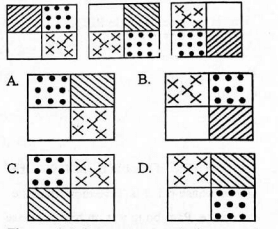
- The graph below represents the journey of a motorist travelling from town P to Q.
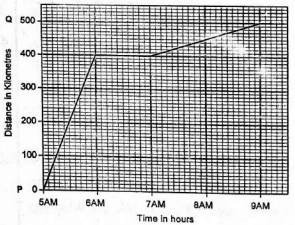
What was the average speed for the whole journey?- 80km/h
- 100km/h
- 200km/h
- 125km/h
MARKING SCHEME
- A
- C
- B
- D
- B
- B
- A
- C
- D
- D
- A
- D
- C
- D
- B
- D
- A
- B
- D
- C
- D
- A
- A
- B
- D
- C
- C
- C
- B
- A
- C
- D
- C
- D
- A
- A
- C
- A
- D
- D
- B
- B
- B
- D
- D
- B
- A
- D
- C
- D


